Well, knowing these 2024 food trends will help you stay ahead of the curve, impress your family and friends, and most importantly, have fun while exploring new flavors and techniques. Interested to find out what food or foods are growing in popularity this year?
Well, keep on reading! In this article, we’ll dive into some of the top food trends of 2024 that are shaping the culinary landscape. You never know, you might be able to incorporate these trends into your own home cooking and food-selling adventures!
Top Food Trends in 2024 # 1: Mood-Boosting Foods
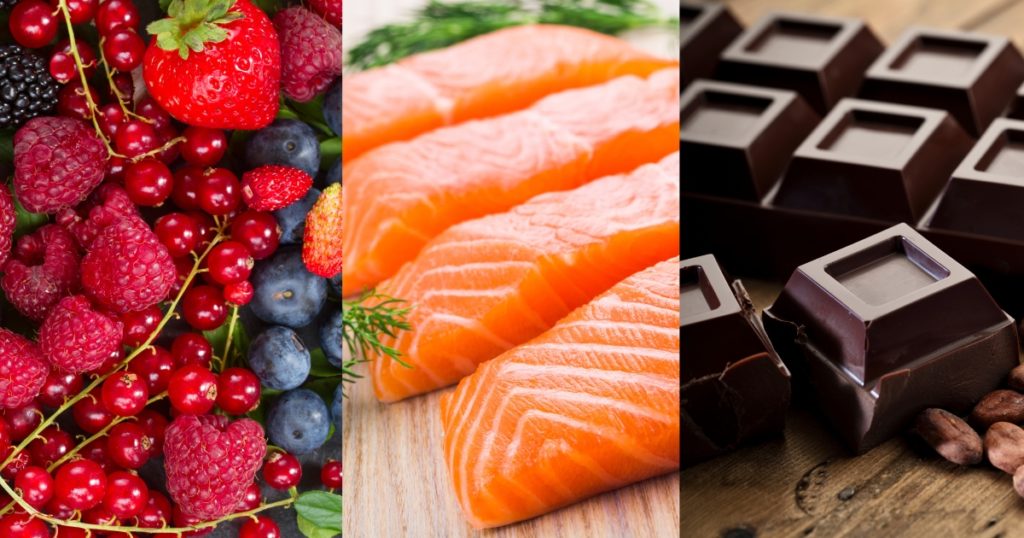
According to UpMenu.com, mood-boosting foods are gaining popularity as more people recognize the direct link between nutrition and mental well-being. These foods contain nutrients that support brain health and help maintain emotional balance.
In addition to enhancing mood, these foods can improve memory and focus, giving you the energy to get through your day. Wondering what these foods are, exactly?
Here are some excellent mood-boosting ingredients you can start using in your recipes:
- Dark chocolate: Considered as a superfood, dark chocolates stimulate the production of endorphins, the brain’s natural feel-good chemicals, and provide magnesium, a mineral known to combat stress and anxiety. We talk about this and about other chocolates in this article.
- Berries: Strawberries, blueberries, and raspberries are packed with antioxidants and can help reduce stress. The anthocyanins and polyphenols found in berries have been linked to mood improvement.
- Nuts and seeds: Almonds, walnuts, and chia seeds are examples of nuts and seeds that are rich in plant-based protein, healthy fats, fiber, and nutrients that support brain health.
- Fish: Salmon and other fatty fish contain omega-3 fatty acids, which are great for your brain and mood.
- Whole grains: Oats, brown rice, and whole wheat bread can help regulate mood and are rich in B vitamins, which are known, again, for boosting both energy and mood.
Speaking of mood-boosting, one cuisine you should check out is Mediterranean cuisine. That’s because It features fresh, nutrient-dense ingredients like olive oil, fish, nuts, and plenty of fruits and vegetables, all known for their positive effects on mental well-being.
Top Food Trends in 2024 # 2: Personalized Nutrition
Personalized nutrition is another trend on the rise this 2024. According to KHNI, scientific evidence shows that our physiological and health needs vary based on factors like age, gender, and life stages. Consumers and scientists recognize that personalized approaches are more effective than general ones.
That is why there is an anticipated growing demand for food businesses specializing in personalized nutrition. Even as a home chef, you can still get in on the trend by creating delicious and healthy meals tailored to your family’s needs with these ideas:
- Build-your-own salad: Let everyone choose their own vegetables, proteins, and dressings.
- Customizable smoothies: Offer a variety of fruits, veggies, and add-ins like protein powder or yogurt.
- Individualized baked goods: Provide gluten-free, dairy-free, or low-sugar options, or even sugar-free options, such as those that Ms. Chiqui Dingcong provides in her classes.
Top Food Trends in 2024 # 3: Global Fusion
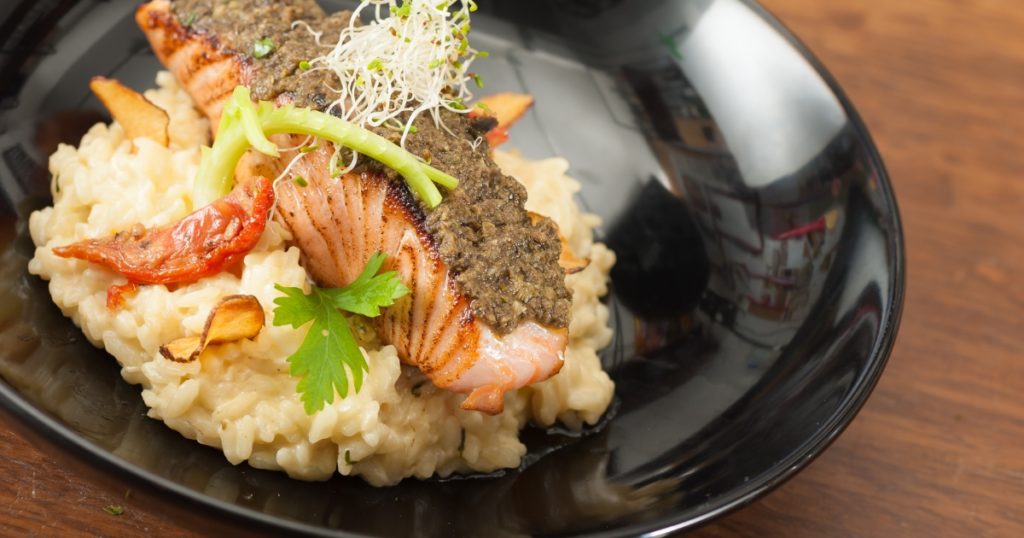
Global fusion cuisine combines elements from various international cuisines to create innovative and unique dishes, merging flavors, ingredients, and techniques from different cultures. This trend is popular because it allows for culinary exploration and reflects a growing appreciation for cultural diversity. It makes cooking more adventurous and helps people experience global flavors at home.
If you enjoy creating new dishes, global fusion is for you. It can be a fun adventure for your taste buds and helps you learn about different food practices around the world. Here are some examples of global fusion meals that you can try:
- Sushi burrito: Combine the flavors of Japanese sushi with the convenience of a Mexican burrito by wrapping sushi ingredients in a seaweed sheet and rice.
- Indian spiced burgers: Mix Indian spices like curry powder and garam masala into ground beef or chickpeas for a unique twist on traditional burgers
- Kimchi tacos: Fill tortillas with Korean kimchi, marinated beef or pork, and a hot sauce for a delicious fusion of Korean and Mexican flavors.
Oh and before we forget, Chef Him Uy De Baron, one of the instructors here at The Bailiwick Academy, has plenty of experience with global fusion. Check out his classes here to get a taste!
Top Food Trends in 2024 # 4: Zero-Waste Gastronomy
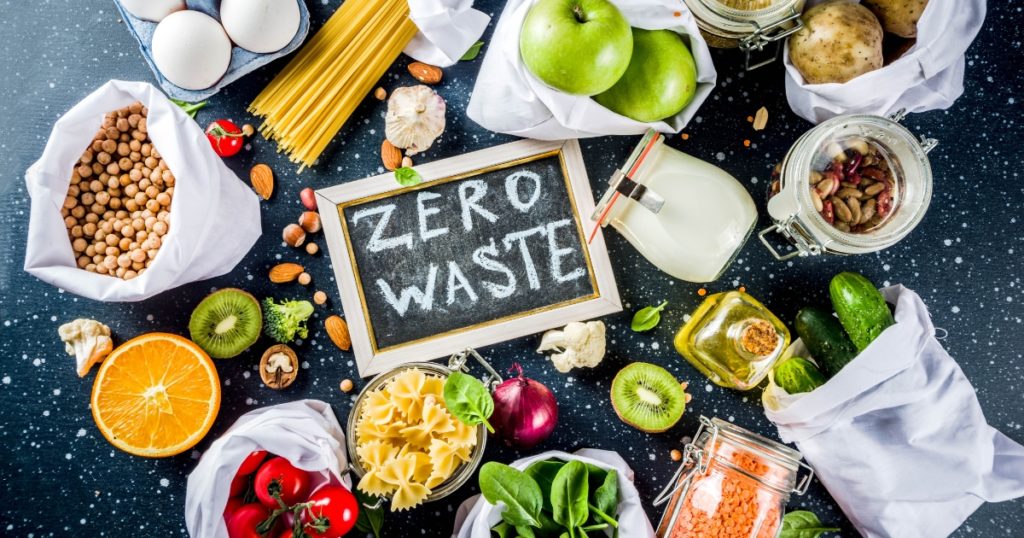
Zero-waste gastronomy is becoming a major trend in 2024 in the food and beverage industry, reflecting a growing commitment to sustainability and environmental responsibility in the culinary world. This approach is all about using every part of your ingredients to make sure nothing goes to waste.
Chefs and home cooks alike are embracing zero-waste techniques, from making stocks with vegetable scraps to creating flavorful dishes from overlooked parts of produce and proteins. This reduces waste and encourages innovation in the kitchen, leading to unique and resourceful recipes.
Want to get in on the trend? Here are some you can try:
- Vegetable scrap broth: Save your vegetable peels, stems, and ends to make a flavorful broth for soups and stews.
- Fruit peel jams: Turn your fruit peels and scraps into delicious homemade spreads, jams, and marmalades.
- Herb stems pesto: Use stems from herbs like parsley, cilantro, and basil to make a unique and flavorful pesto.
By adopting zero-waste gastronomy, you’re helping the planet and discovering new flavors and techniques to elevate your cooking. It’s a win-win for both your kitchen and the environment.
Top Food Trends in 2024 # 5: Culinary Storytelling
Culinary storytelling is another of the top food trends for 2024. No, this doesn’t necessarily involve food writers. Rather, it’s about chefs and restaurants using food and beverages to tell stories and connect with diners. This trend focuses on narratives, such as the origins of a recipe, ingredient sourcing, or the chef’s inspiration.
Diners are increasingly interested in the cultural context and personal touches that make each dish unique, which is why culinary storytelling is trending in the first place. This approach not only enhances their dining experience but also builds a stronger connection with the restaurant.
You don’t have to be a restaurant to embrace this trend, though. Even at home, you can share the stories behind your meals to create a more engaging and meaningful dining experience for your family.
Here are some approaches you can try:
- Family recipe night: Cook a meal using recipes that have been passed down through your family. Share the stories and memories that go along with each dish.
- Personal milestones: Prepare a dish that celebrates a significant moment in your life, like a birthday, anniversary, or other milestone. Share the emotions and memories associated with it.
- Travel-inspired dishes: Make a dish inspired by a place you’ve visited or dream of visiting. Share the story of why that place is special to you.
What is the next big food trend?
Here’s the thing about trends: food trends in 2024, for sure, will not be the same as food trends in 2025. It takes a lot of consumer insight to determine what they will be.
If you’re not looking to get into the food business, that’s okay! You can still try out these trends at home and enjoy experimenting and serving new things to your family.
But what if you do want to start a food business? Simply hopping on the biggest trends might work initially (like ube pandesal or burnt Basque cheesecake), but to ensure long-term success, you need something more sustainable.
Well, you don’t have to look too far; the answer is right here!
Join The Bailiwick Academy’s Food Business Bootcamp!
The TBA Food Business Bootcamp is a 14-week program that will give you the right foundation to build and sustain a successful food business.
Here are the modules you’ll get when you enroll:
- Entrepreneurial Mindset
- Soul Branding
- Branding 101
- Business Basics
- Menu Planning
- Human Resources
- Marketing and Sales
- Accounting
- Food Costing
- Legal Fundamentals
- Employment Law
- Business Planning
Plus, you get three bonus classes:
- Excel Basics for Food Business Owners
- Meat Processing Classes
- Mobile Food Photography
At the end of this, you’ll learn how to have a business that’s low-risk, low-maintenance, and high return of investment…
Even without necessarily paying attention to food trends in recent months.
So what are you waiting for?
Go to this page to learn more about the Food Business Bootcamp!
Oh, and of course, for you to officially join, sign up at The Bailiwick Academy. That way, you’ll get access to plenty of classes, too!
See you inside the boot camp or inside one of the TBA classes!
—
Keep coming back to The Bailiwick Academy blog for more kitchen tips, tricks, and much more!
]]>Whether you’re aiming to bake pizza yourself or simply love eating it, getting to know the various kinds is both fun and interesting. Let’s get started!
A Brief History of Pizza
What exactly is pizza? Well, pizza, like Torta Caprese, is from Italy. It is a round and flat, wheat-based dough topped with tomatoes, cheese, and other ingredients, and baked until the pizza crust is crispy and golden, and the cheese is bubbly and melted to perfection. But how exactly did it come to be?
According to Peatzeria, pizza evolved from flatbreads sold by street vendors in the late 18th century. The vendors topped with garlic, salt, herbs, lard, cheese, and other ingredients. They sold them primarily to low-paid workers seeking convenient and satisfying food.
Thankfully, in 1889 King Umberto I and Queen Margherita of Italy were impressed by a pizza topped with basil, mozzarella, and tomatoes, created by Raffaele Esposito to reflect the colors of the Italian flag. This pizza, known as the Margherita, gained royal approval. It also marked a significant moment in pizza history, making it go from street food to popular fare.
And in the 20th century, pizza gained popularity worldwide, especially in America. It became a favorite among Allied troops during World War II and later spread as Italians migrated to other countries and international travel became more common. This is also when different styles of pizza started popping up.
What are the different styles of pizza, exactly? Well, on to the main section of this article!
A Quick Disclaimer
This list doesn’t represent all different kinds of pizza. It’s just a taste of what we feel are some of the most popular and interesting kinds. We hope it gets you excited to try new pizzas and explore more on your own.
Here are some of the different kinds of pizzas you should make!
Different Kinds of Pizzas to Make 1: Margherita Pizza

Margherita pizza, a kind of tomato pizza, is one of the oldest flavors of pizza. It’s a classic Italian pizza composed of a thin crust topped with tomato sauce, fresh mozzarella cheese, basil leaves, a drizzle of olive oil, and a sprinkle of salt.
It’s simple, light, and possibly the purest form of pizza you’ll ever taste. Hey, it was approved by royalty, so it’s definitely good enough for all of us!
Different Kinds of Pizzas to Make 2: Pepperoni Pizza

Pepperoni pizza is one of the most popular pizzas in the United States—according to a 2017 Harris Poll, 36% of Americans prefer pepperoni on their pizza above all other toppings! It’s not hard to imagine why. The combination of a crispy crust, tangy tomato sauce, gooey mozzarella cheese, and the spicy kick of pepperoni slices creates a perfect balance of flavors and textures that many find irresistible.
The flavor appeal actually extends to the rest of the world. We’re sure you’d agree that pepperoni pizza is one of the most recognizable pizzas in the world.
Oh, and fun fact? Pepperoni pizza is not from Italy—this pizza is more of an Eastern European/American-Italian version.
Different Kinds of Pizzas to Make 3: Hawaiian Pizza

With all kinds of pizza toppings, how could anyone have thought of putting pineapple on pizza? Hawaiian pizza, which mixes sweet and savory tastes, is a bit of a debate starter. It usually has a thin crust with tomato sauce, mozzarella cheese, ham, and pineapple chunks.
Funny enough, the origin of this pizza is not from Hawaii—and there are conflicting origin stories. Some sources attribute the creation of Hawaiian pizza to Sam Panopoulos, a Greek immigrant in Canada. Supposedly, he added pineapple and ham or bacon to pizza at Satellite Restaurant in Chatham, Ontario in 1962.
Other evidence suggests that it was a pizzeria in Portland, Oregon where it all started. It was a store named Pizza Jungle that advertised a pizza with papaya, chopped green pepper, and pineapple as early as 1957, naming it the Hawaiian Pizza.
No matter the origin, this pizza is controversial. It’s popular with Americans, but we suggest never bringing this flavor up with Italians.
Different Kinds of Pizzas to Make 4: Neapolitan Pizza
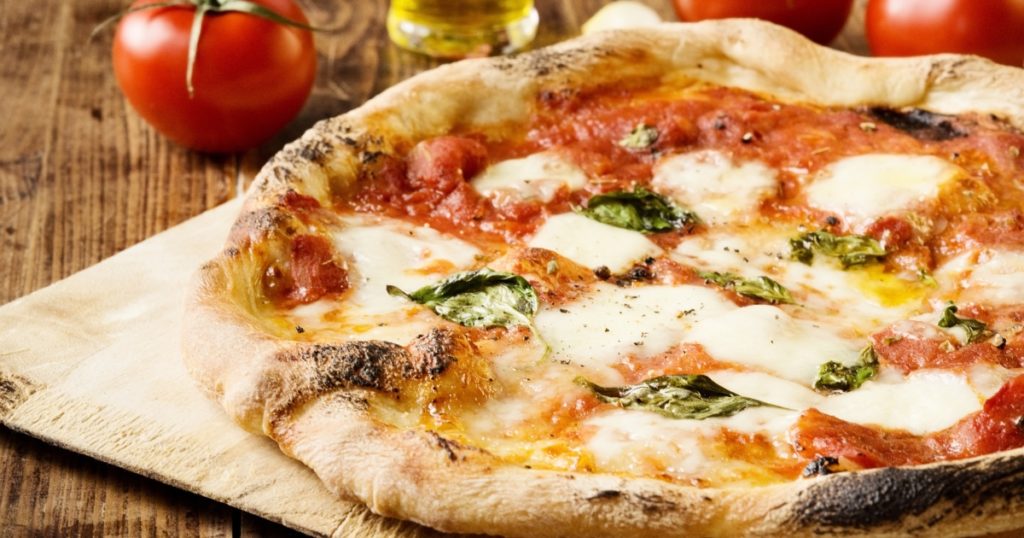
A Neapolitan pizza takes the classic Margherita to the next level with extra sauce and cheese. This pizza comes from Naples, Italy, and is famous for its thin, tender crust. It’s usually covered with San Marzano tomatoes, fresh mozzarella, basil, salt, and a drizzle of extra-virgin olive oil.
This pizza is baked in a wood-fired oven at high heat. The result is a beautifully blistered crust and a deliciously smoky taste.
According to Pizza Bien, a pizza can only be considered a true Margherita if it meets four main criteria, as outlined by the Associazione Verace Pizza Napoletana:
- You may use only San Marzano tomatoes.
- You can use only fresh mozzarella. The mozzarella must be made from water buffalo milk or a mix of cow and water buffalo milk. This specific type of milk is chosen for the rich, creamy texture and taste it imparts to the cheese.
- The dough must be expertly prepared using only flour, yeast, salt, and occasionally sugar and beer.
- The pizza must be cooked in a wood-fired oven at approximately 900 degrees Fahrenheit. It is a process that takes just 60 to 90 seconds.
These strict guidelines ensure the preservation of the authentic Neapolitan pizza’s traditional essence.
Different Kinds of Pizzas to Make 5: Chicago Deep Dish Pizza
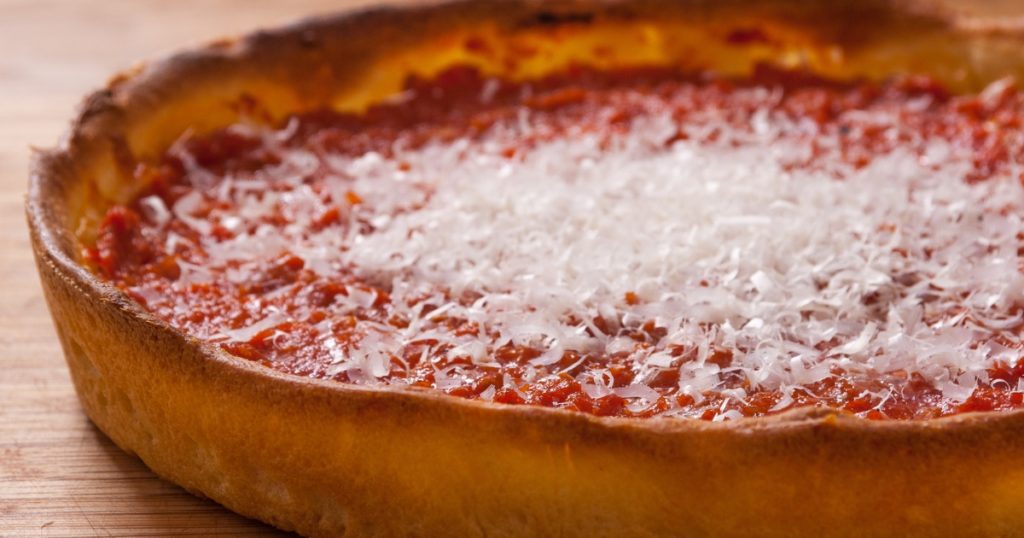
Out of the different types of deep dish pizza, Chicago Deep Dish pizza is one of the most well-known ones.
Originating in Chicago in 1943, It features a thick, buttery crust that lines a deep pan, creating a deep dish. The pizza is assembled with toppings such as Italian sausage, onion, peppers, and mushrooms, followed by a layer of fresh mozzarella cheese and chunky tomato sauce. Due to its thickness, Chicago deep pizza requires a longer baking time in the oven.
This style of pizza has become synonymous with Chicago and is celebrated for its hearty and indulgent nature. Oh, and this pizza’s indulgent nature and meaty flavors demand the use of a knife and fork for a better dining experience. We’d definitely call it one of the best dinner ideas (or lunch)!
Different Kinds of Pizzas to Make 6: California Pizza
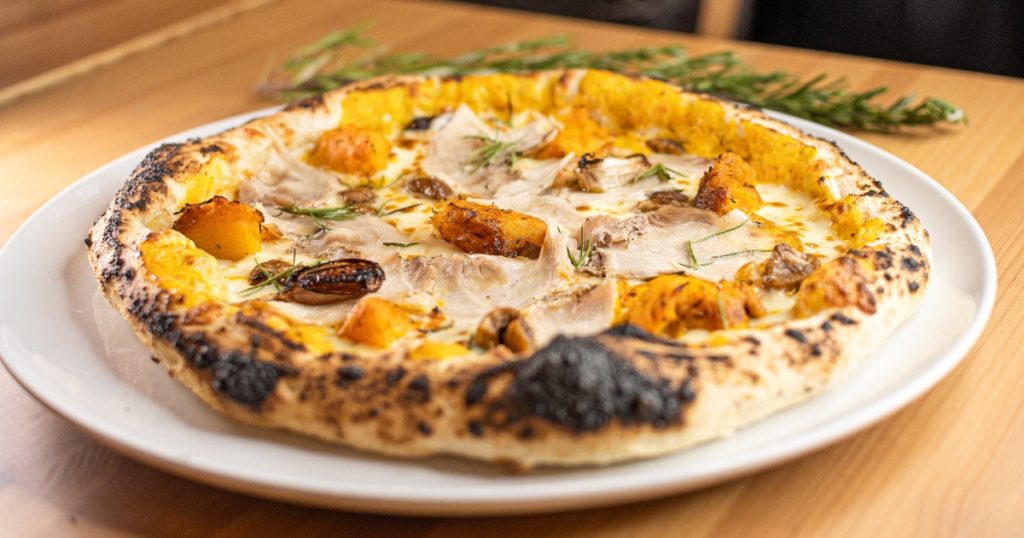
California pizza is a style of pizza that originated in California, United States. It blends influences from New York and Italian thin-crust pizzas with toppings inspired by California cuisine. Adventurous eaters will love its creative pizza toppings such as barbecue sauce, bbq chicken, avocado, sun-dried tomatoes, and goat cheese. Some makers even add spinach, artichoke hearts, and peanut sauce.
It is often baked in a wood-fired oven or on a pizza stone. It can be served with either thin and crispy pizza crusts or thicker and chewier ones.
Different Kinds of Pizzas to Make 7: New York-Style Pizza
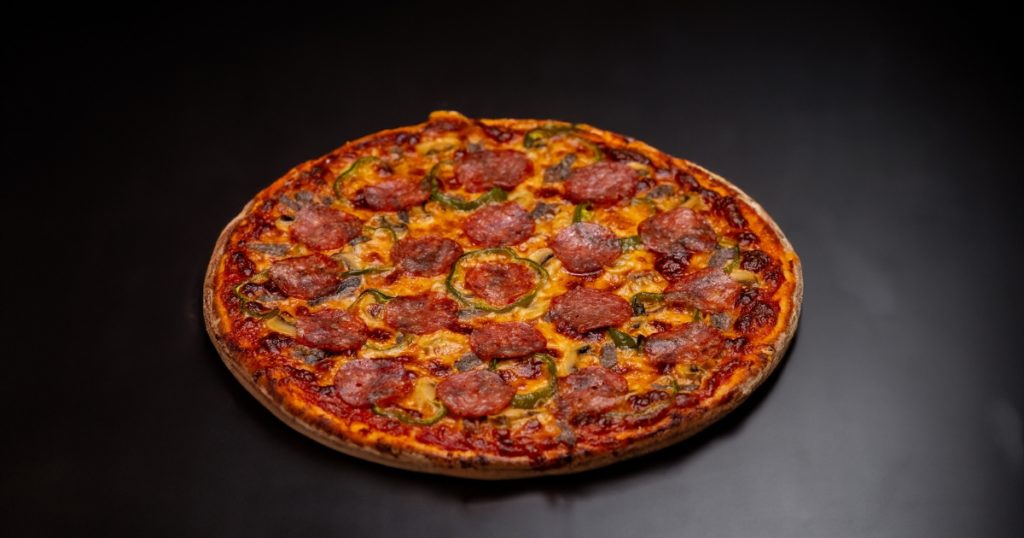
New York-style pizza is all about big, foldable slices with a thin, slightly chewy crust. Pizza makers toss it by hand and top it with tomato sauce and stretchy, low-moisture mozzarella. You can jazz it up with extras like pepperoni, mushrooms, or sausage. Baked in a gas oven, it gets a perfectly crispy yet bendy crust.
This pizza came to life when Italian immigrants hit New York City in the early 1900s. The dough’s made with high-gluten flour, a bit of sugar, olive oil, yeast, and water, giving it a unique taste and texture. The sauce? It’s a seasoned mix of tomatoes, garlic, and herbs, slathered over the crust before adding cheese and other toppings. And if you like, sprinkle on some garlic powder, red pepper, oregano, or Parmesan after baking.
Different Kinds of Pizzas to Make 8: Mushroom Pizza
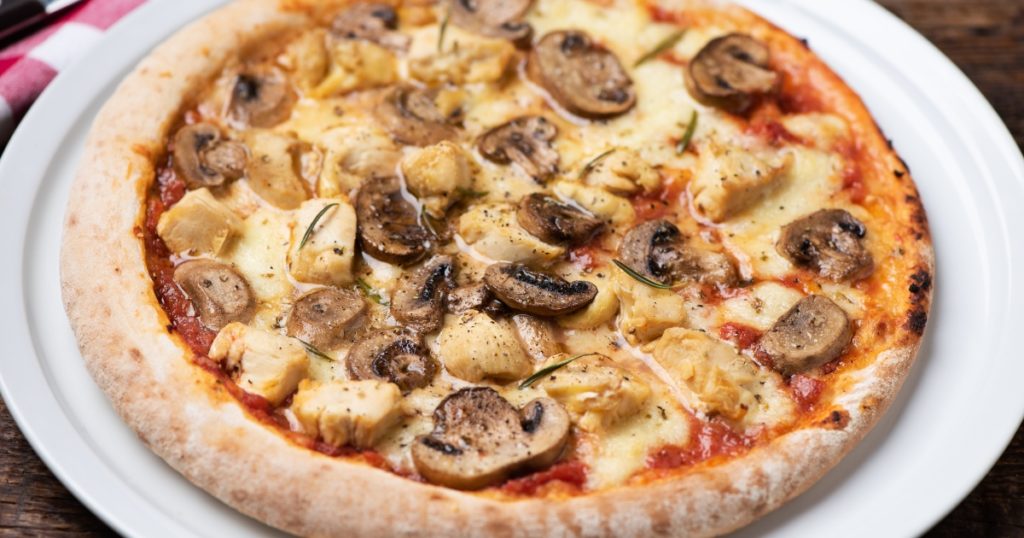
Mushroom pizza is a classic choice for pizza lovers who are looking for vegetarian recipes. It’s simple: a thin or thick crust topped with tomato sauce, lots of mozzarella cheese, and heaps of mushrooms. Whether you like your mushrooms sautéed first or thrown on fresh, they add a juicy, earthy flavor to the pizza that’s hard to beat.
This pizza is perfect for those who love a bit of nature’s bounty on their plate. You can stick to just mushrooms or mix in other toppings like onions, peppers, or different cheeses to make it your own. Bake it until the cheese is bubbly and golden, and you’ve got a delicious mushroom pizza ready to enjoy!
Which type of pizza is the most popular?
It’s hard to say which type of pizza is the most popular because everyone has their own favorite. With so many kinds of pizzas out there, from classic cheese and pepperoni to more unique flavors like Alfredo Pizza or Buffalo Chicken Pizza, it really depends on personal taste.
Some people love the simplicity of a Margherita, while others prefer the variety of a supreme pizza—and some even love pizzas with black olives. In the end, it really depends on who you ask. Everyone has their own favorite when it comes to eating pizza, that’s for sure!
Want to learn the different types of pizza to make at home?
Finished reading and feeling inspired for a pizza night at home? Why settle for delivery when you can craft your own perfect pizza, ensuring top-notch quality every time? That’s why homemade pizza is better—it’s simply unbeatable.
But where can you get recipe collections for homemade pizza? Well, you don’t have to go far. Just enroll in Chef Joey Prats’ newest class here at The Bailiwick Academy: Pizza Master Class Deluxe!
Enroll and get hands-on with these eight pizza styles:
- Cast Iron Pan Pizza
- Chicago Style Deep Dish
- Detroit Style Pizza
- New York Style Pizza
- Roman Style Pizza Bianca
- Sicilian Style Stuffed Crust with Vodka Sauce
- California Style BBQ Chicken Pizza
- Neapolitan Style Pizza
Just like all the classes at The Bailiwick Academy, it’s an easy-to-follow class, perfect even if you’re a beginner. You’ll not only learn to make these diverse pizzas but also gain skills that go beyond the basics. This class is your ticket to making the perfect pizza every night.
Soon enough, you’ll be on your way to starting a food business. Maybe it will even be one where you transport your baked pizza pie to your customers.
What are you waiting for? Sign up at The Bailiwick Academy today and start your journey to being one of the best pizzaiolos ever!
—
Keep coming back to The Bailiwick Academy blog for more cooking and baking tips, kitchen tricks, and much more!
]]>From the deep, molasses-rich tones of dark brown sugar to the delicate, melt-in-your-mouth quality of powdered sugar, understanding these varieties can elevate your baking from the everyday to the extraordinary. Whether you’re crafting a tender pound cake, a batch of chewy sugar cookies, or a glossy meringue, knowing the right sugar to use can make all the difference.
Let’s explore these 11 types of sugar and how they can can make a world of difference in your baking.
Note: This was originally posted last February 24, 2021. This was updated on February 24, 2024.
11 Types Of Sugar #1: Granulated Sugar

Granulated sugar, also known as table sugar or white sugar, is one of the common types of sugar. You make this from either sugarcane or sugar beets. You’ll also know this sugar by its fine, crystalline texture.
In baking, since it has a neutral taste, granulated sugar is a powerhouse ingredient, responsible for not just sweetening your favorite comfort food (i.e. pastries, cookes, cakes), but also contributing to their texture and structure. It aids in the creaming process, where you beat the sugar with fat (like butter) to incorporate air into the batter, resulting in a light and fluffy texture. Granulated sugar also helps in caramelization, giving baked goods a golden-brown crust and a subtle depth of flavor.
Mastering the use of granulated sugar can elevate your baking, making it a fundamental skill for any baker.
11 Types Of Sugar #2: Brown Sugar (Light And Dark)

Light brown sugar, a staple in baking, offers a golden brown color and caramel flavor to baked goods. It contains about 3.5% molasses, adding moisture and chewiness that you don’t get from white sugar.
Dark brown sugar, on the other hand, with nearly twice the molasses content at around 6.5%, brings a deeper color and more robust flavor to recipes. This difference means using any brand of dark brown sugars instead of light can significantly affect the moisture, taste, and color of your baked goods, making them darker and more intensely flavored.
Oh and cool trivia: if you need it but you don’t have any, you don’t have to look for any substitute for brown sugar; you can just make your own! Just mix 1 cup of white sugar with 2 tablespoons of molasses for homemade light brown sugar. For dark brown sugar, simply increase the amount of molasses.
11 Types Of Sugar #3: Confectioner’s Sugar

Confectioner’s sugar, also known as powdered sugar or icing sugar, is finely ground regular white sugar and sifted to make a smooth powdery texture. Cornstarch is then added to the powdered sugar to prevent it from caking.
This fine sugar dissolves easily, making it ideal for frostings, icings, and ensuring a tender texture in baked goods. You can use this to dust, say, donuts and other sweets for visual and flavor appeal. It’s also perfect for sweetening whipped cream without the grittiness of granulated sugar.
Want to make your own at home? Just mix 1 cup of granulated sugar and blend it with one tablespoon of cornstarch in a food processor. Voila!
11 Types Of Sugar #4: Cane Sugar

Cane sugar comes directly from the sugarcane plant and is less processed than granulated white sugar, retaining a bit of the natural molasses flavor and color. This sugar is known for its slightly larger crystals and a richer taste compared to standard white sugar.
In baking, cane sugar is a fantastic choice for bakers looking to add a hint of molasses flavor and a touch of richness to their creations without straying too far from the familiar results of white sugar. That’s especially true since it offers a subtle depth of flavor that enhances the overall taste of baked goods. It’s particularly good in recipes where a caramel-like sweetness is desired, such as in crumbles.
A note though: given its slightly larger crystal size, ensure it’s fully dissolved in mixtures to avoid a gritty texture, especially in beverages or fine pastries.Oh and one more cool note: Studies show that cane sugar contains high levels of polyphenols – potent antioxidants that can neutralize damaging free radicals in the body. Unlike regular white sugar, cane sugar also retains some vitamins and minerals from the sugarcane plant such as calcium, magnesium, and potassium. While moderate use is still advised, these nutrients give cane sugar a bit of an advantage over white sugars.
11 Types Of Sugar #5: Caster Sugar

Caster sugar is also known as superfine sugar. This sugar dissolves more quickly than regular granulated sugar, making it highly preferred for delicate baked goods like soufflés that need a certain mouthfeel. This type of sugar is also ideal for making meringues and cocktails, since it blends seamlessly into mixtures, ensuring little to no grittiness.
It’s a favorite for bakers who create exquisite desserts!
11 Types Of Sugar #6: Muscovado Sugar

Muscovado sugar is a minimally processed sugar type. It’s a sugar with high molasses content, a rich complex flavor, and a moist sandy texture—it will remind you of butterscotch, actually. Its strong flavor is much more pronounced than that of traditional brown sugars, making it a distinctive choice for both sweet and savory dishes.
Muscovado sugar shines in recipes where its robust flavor can stand out, such as in molasses cookies, gingerbread, and rich chocolate cakes. It adds depth and complexity to desserts that benefit from its bold molasses notes.
Its rich taste is also a great addition to savory sauces and marinades, offering a balance of sweetness with a hint of bitterness. It can transform barbecue sauces, glazes, and even slow-cooked meat dishes.
And of course, it’s perfect for coffee!
11 Types Of Sugar #7: Raw Sugar (Turbinado And Demerara)

Raw sugars like Turbinado and Demerara are less processed than white refined sugars, retaining a natural golden-brown color and a slight molasses flavor. Turbinado sugar has large, sparkling crystals and a subtle caramel taste, while Demerara sugar has slightly larger crystals and a richer flavor profile. Raw sugars retain a light coating of molasses, unlike fully refined sugars that have the molasses completely stripped away. This gives raw sugars their distinctive color and taste.
Turbinado sugar’s larger crystal size and mild flavor make it ideal for topping muffins, cookies, and crumbles, adding a crunchy texture and a hint of sweetness. On the other hand, Demerara sugar’s richer flavor and crunchy texture work well in coffee, tea, and on top of baked goods. It’s also excellent for creating a caramelized crust on desserts like crème brûlée or sprinkled over fruit before baking.
11 Types Of Sugar #8: Liquid Sugar

Want liquid sugar? Just dissolve sugar in water and get a clear, sweet syrup. This form of sugar is ideal for beverages, such as coffee and tea, but it also has its place in baking and cooking.
Its main advantage in the kitchen is its ability to blend seamlessly into mixtures, eliminating the need for dissolution that granulated or powdered sugars require. This makes it particularly useful for moist cakes, sweet breads, and smooth sauces and glazes where a consistent sweetness is crucial.
11 Types Of Sugar #9: Sanding Sugar
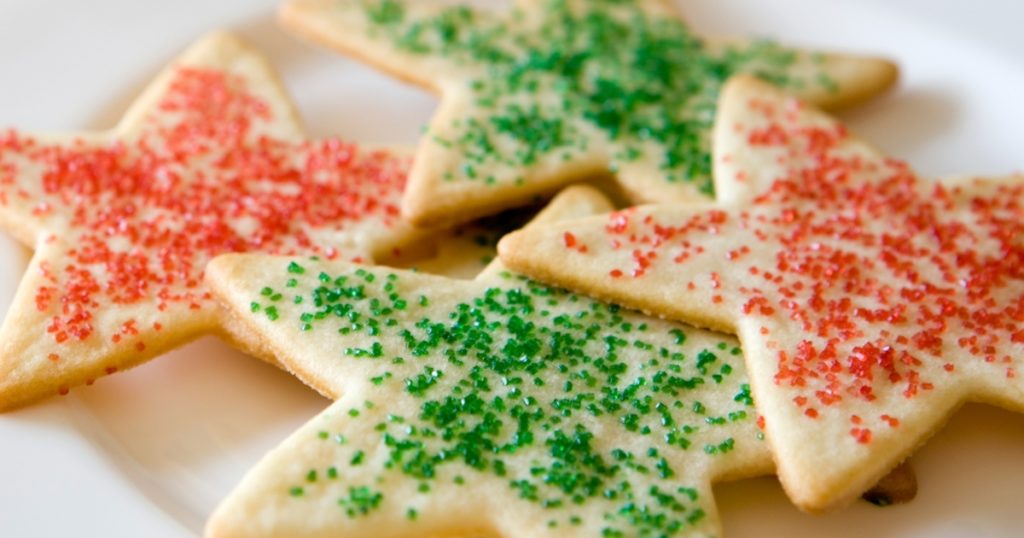
Bakers often use sanding sugar’s large, coarse crystals that sparkle and shine to add a decorative touch to baked goods. Unlike finer sugars, sanding sugar retains its texture and appearance even after baking, providing a beautiful, glittery effect on the surface of cookies, cakes, and pastries. Its availability in various colors further enhances its appeal, allowing for creative and vibrant decorations that catch the eye—perfect for holiday treats!
For best results, sprinkle sanding sugar on top of cookies, scones, or muffins just before baking. This ensures the sugar adheres well to the surface and maximizes its sparkling effect. You should also brush your bakes with a light egg wash to make the crystals stick better and stay in place.
11 Types Of Sugar #10: Pearl Sugar

Pearl sugar, sometimes called nib sugar, consists of large, white, opaque granules that retain their shape and do not melt during baking. You use this kind primarily for decoration, adding a crunchy texture and a visually appealing finish to baked goods. It has a coarse hard texture and is opaque in color.
Pearl sugar is perfect for professional or home bakers looking to add a distinctive crunch and decorative flair to their baked creations. Mix it into doughs for items like Belgian waffles or sweet breads for pockets of sweetness. You can also use pearl sugar as a finishing touch on frosted cakes, rolls, and buns for added texture and visual appeal.
11 Types Of Sugar #11: Coconut Sugar
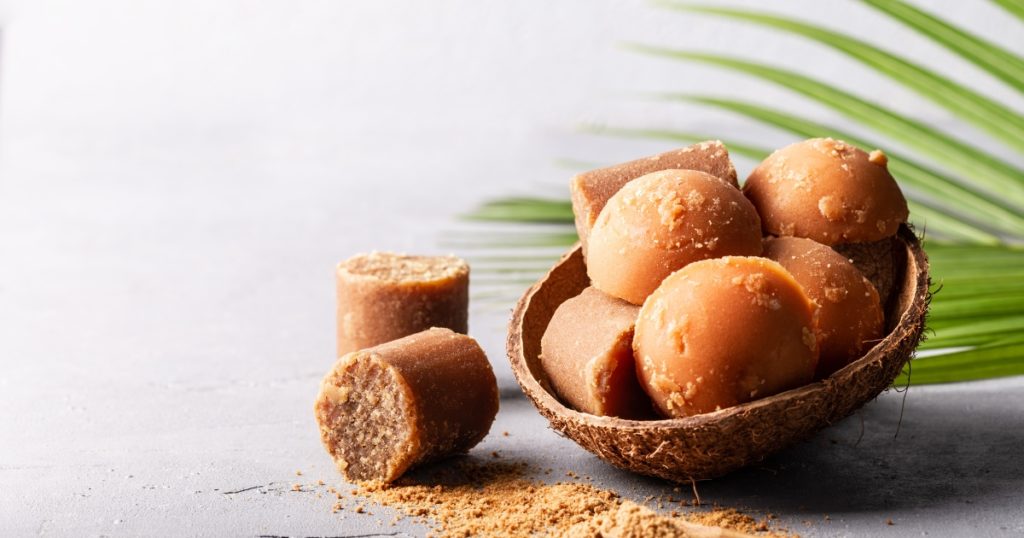
You get coconut sugar from the sap of the coconut palm tree. Among the variety of sugars, people know coconut sugar for its lower glycemic index compared to regular white sugar, making it a popular choice among those looking for healthier sugar alternatives. It also contains trace amounts of vitamins, minerals, and phytonutrients, adding a slight nutritional edge.
Flavor-wise, coconut sugar offers a subtle caramel-like taste, which can enrich the flavor profile of baked goods with a deep, warm sweetness.
Exploring the Sweet Possibilities: What’s Next?
Now that you’re familiar with these common sugars, it’s time to put this knowledge into action. Each type of sugar offers unique properties and flavors that can transform your baking and cooking, elevating simple recipes into something truly special. Here’s how to take the next steps in your culinary journey:
- Experiment with Substitutions: Start by substituting different sugars in your favorite recipes. Use coconut sugar instead of white sugar for a healthier option, or try muscovado in place of brown sugar for a deeper flavor. Remember, the key is to consider the moisture content and flavor profile of each sugar type.
- Adjust Recipes to Taste: As you experiment, adjust recipes based on the sweetness and flavor of the sugar you’re using. Some sugars are sweeter than others, so you may need to use less to achieve the desired taste. Additionally, the unique flavors of sugars like coconut or muscovado can add an unexpected twist to classic dishes.
- Focus on Texture and Color: Consider how the sugar affects the texture and color of your baked goods. For example, pearl sugar adds a delightful crunch to waffles and breads, while sanding sugar gives a sparkling finish to cookies and cakes.
- Creative Decorations and Finishes: Use sugars not just for their sweetness but as decorative elements. Experiment with colored sanding sugars for festive occasions or use powdered sugar for a delicate, snow-like dusting on desserts.
- Moderation is Key: As we discover new types of sweeteners for baking, we must also consider their impact on well-being. Consume sugar moderately. Striking a balance allows us to enjoy sweets without excess. We may even wish to explore sugar substitutions (i.e. the ones used for keto recipes) to support dietary needs. There are ways to craft delicious recipes while being mindful of our bodies.
Final Thoughts
Learning about the different common types of sugar is the first step to transforming your baking. Each sugar adds its own flavor and texture, letting you get creative in the kitchen. Whether trying healthier coconut sugar or experiencing the molasses taste of muscovado, the right sweetener can take your recipes from good to great.
I encourage you to experiment with these unique sugars in your baking projects. It’s not just about new tastes – it’s about making even better desserts. So grab an apron and see what sweet ideas you can whip up!
If you want to improve your skills more, The Bailiwick Academy offers fun baking and cake decorating classes. Sign up at The Bailiwick Academy today and try one of our courses now!
—
Keep coming back to The Bailiwick Academy blog for more cooking and baking tips, kitchen tricks, and much more!
]]>I hope you get inspired by them!
Why Catering Is A Big Opportunity in 2024
2024 is shaping up to be a great year for starting a catering business. What makes me say this, you ask?
- There are already projections of more business meetings and corporate events this year. And if you remember one of my tips for standing out as a catering business, it’s to close plenty of corporate clients. 2024 makes it super possible to succeed in catering.
- There are always weddings here in the Philippines. For example, according to the Philippine Statistics Authority (PSA), the number of people who got married increased from 2019 to 2022. I’m pretty sure the same thing happened in 2023, and will happen in 2024!
- And of course, Filipinos love to party and celebrate special occasions such as baptisms or birthdays. And with celebrations always come food, which means more catering opportunities success—and income!
Those three are more than enough reasons, wouldn’t you agree?
How To Really Succeed In Catering
Are you now really, REALLY encouraged to try your hand at catering this 2024? I hope so, especially if you’ve been dreaming of coming up with a cooking and baking empire for a long time already!
Now, how exactly do you go about it? Sure, I gave you seven tips to get started on a catering business… but I feel like the best way to really find out is to check out some of the best caterers in the Philippines!
I did a quick search, found this list, and this list, and found some commonalities of what makes them great, according to the lists:
- Delicious food of different cuisines
- Great service
- Beautiful setups
- An overall amazing experience
But here’s the thing: knowing what makes a great caterer and actually implementing these things are two different sides of the coin.
Besides, even if you know, how can you be sure that you can apply the knowledge and actually achieve catering greatness?
Well, that’s where Catering 101 of The Bailiwick Academy comes in!
Succeed in Catering in 2024 With Catering 101
Our Catering 101 course is like a training camp for caterers, perfect for enthusiastic home cooks like you.
You’ll pick up skills to make your catering business really stand out. This includes learning effective marketing, creating a memorable menu, and setting the right prices to ensure good profits.
We’ll show you how to smoothly handle tough situations and demanding customers. Plus, you’ll learn ways to make such a great impression that your customers will be eager to return.
This course is filled with tips and tricks from some of the Philippines’ top caterers and chefs.
By the end of it, you’ll be ready to handle big events, lead a great team, and have the know-how to expand your catering business.
Who will be teaching Catering 101?
We were on the lookout for caterers who could help us make this class really comprehensive… and we’re lucky that we already have onboard Chef Him Uy De Baron!
Chef Him is hailed as one of the biggest names in the culinary world, Chef Him runs various restaurants all over the Philippines and is one of the instructors inside The Bailiwick Academy since 2022.
Check out the preview of this class here:
But it’s not just Chef Him. Meet the others:
- Beejay Tantoco, who runs his family catering business Tantoco’s Catering (established in 1994) where they close government accounts, serve celebrities, and entered popular food markets like Mercato and Bancheto.
- Chef Kalel Chan, a corporate chef of Raintree Restaurants which operates 10 restaurants — Farmer’s table, Saboten, Cha Cha’s Boracay, The Coconut Club, Izakaya Sensu, My Country House, Jones All Day, and so much more. He’s famous for The Original Ube Champorado!
- Aileen Ferrer, a Bailiwicker, our community manager of the TBA Student Lounge, and a businesswoman who runs “Unwrapped – Flowers, Hampers and Events” — a flourishing floral and event styling company that works with corporate clients, weddings, and various events.
- Michelle Lazaro, another Bailiwicker who runs Balai Calamba, a catering business based in Laguna. She also owns two commercial kitchens strategically located in Las Piñas and Laguna. She has catered for corporate events of Hyundai, Chery, and Foton.
- We also have a mystery chef! He has been in the food business for almost 20 years. His experience includes working for Nestle as a Regional Chef Consultant, running a Catering Business since 2004, and starting a new food business last 2022. You’ll find out who he is when you join the program!
How Catering 101 Will Go
Catering 101 starts on January 28, 2024, and will be broken up into six strategic modules to help you succeed in catering.
Week 1: Laying the Foundations For a Successful Catering Success
This week, you’ll dive into the essentials of starting a catering business. This includes understanding the market, the diverse roles in catering, and what initial capital you’ll need. You’ll also learn about building a strong team, crucial for a successful operation.
- Discover the catering market opportunities, especially in the Philippine context.
- Learn directly from industry experts about starting a catering business, covering everything from capital needs to logistics.
- Understand the various roles you’ll play, from chef to business strategist.
- Get a detailed breakdown of initial capital requirements for budget planning.
- Learn how to assemble a strong team, including roles like event managers and chefs.
- Gain real-world insights from successful caterers on launching and growing your business in the Philippines.
- Balance your passion for food with the skills needed for running a successful business.
Week #2: Crafting a Unique Brand that Makes Sales and Marketing Simple
Week 2 focuses on branding, sales, and marketing in the catering industry. You’ll learn how to differentiate your business in a competitive market and make an impact.
- Understand the different catering types and their unique needs.
- Learn how to evaluate your competition and identify your unique selling points.
- Gain insights from real-life examples on effective brand positioning.
- Learn how to engage potential clients with compelling sales pitches.
- Create a targeted marketing plan and schedule.
- Learn the steps for testing your business concept before a full-scale launch.
- Understand the importance of maintaining good relationships in corporate catering.
Week #3: Create Irresistible Menus and Aesthetically-Pleasing Meals Like a Catering Pro
In Week 3, you’ll delve into menu planning and food presentation, learning how to create menus that are both delicious and practical for catering.
- Explore various menu styles and learn how to select the best for different events.
- Learn recipe selection that’s both tasty and catering-friendly.
- Understand the challenges of catering food, including logistics and quality maintenance.
- Acquire skills in food presentation to enhance event dining experiences.
- Learn essential food safety practices.
- Manage supplies effectively and build strong supplier relationships.
- Get advice on setting up an efficient off-site kitchen.
Week #4: Costing and Pricing Best Practices to Maximize Profits
This week is all about the financial side of catering, focusing on recipe costing, pricing strategies, and understanding overhead costs.
- Learn to cost recipes accurately and understand their financial impact.
- Develop effective pricing strategies that reflect your service’s value.
- Understand the overhead costs involved in catering.
- Design profitable and appealing menus.
- Develop financial management skills for long-term success.
- Balance cost-effectiveness with high-quality offerings.
- Adapt pricing strategies to market dynamics and customer expectations.
Week #5: Master the Essentials of Booking, Service, and Crisis Management
The fifth week covers the practical aspects of managing catering events, from booking to service standards and crisis management.
- Learn the comprehensive process of booking events.
- Master creating a BEO for outlining event details.
- Develop a culture of excellent service in your team.
- Handle crises and difficult clients professionally.
- Follow up with clients post-event for feedback and repeat business.
- Use successful events as marketing tools while respecting client privacy.
Week #6: The Essentials of Table Styling for Every Occasion
In the final week, you’ll learn the art of table styling, ensuring your setups are as memorable as your food.
- Learn to set up buffet and dining tables for various events.
- Choose the right serving and dinnerware to enhance the dining experience.
- Discover flower arrangement tips for stunning table displays.
- Customize table setups for different themes.
- Receive step-by-step instructions for flawless table presentations.
By the end of these six weeks, you’ll have a comprehensive understanding of starting and running a successful catering business, equipped with practical skills and insider knowledge!
How To Enroll In Catering 101
It’s easy! All you have to do is sign up at The Bailiwick Academy then go over to the Catering 101 Page. Enroll, and then make sure to block off January 28, 2024, as that’s the first day of class!
Final Thoughts About How To Succeed in Catering in 2024
Looking ahead to 2024, it’s clear that there’s a big chance for success in the catering business. With more companies holding events, lots of weddings, and Filipinos loving big celebrations, there’s plenty of work for caterers.
To really do well in catering, you need to mix your love for cooking with smart business skills. That’s where our Catering 101 course at The Bailiwick Academy comes in. It teaches you everything from understanding what customers want to making your catering stand out, to handling money matters.
You’ll learn from experts like Chef Him Uy De Baron, who know all about making great food and running a successful business. They’ll share their secrets on how to make your catering unforgettable and how to handle any tough situations that come up.
Don’t miss this opportunity to turn your passion into a profitable venture! Become one of the Bailiwickers trained by successful food business owners on how to launch a catering business in 2024.
Join Catering 101 today. See you inside!
—
Keep coming back to The Bailiwick Academy blog for more baking and cooking tips, kitchen tricks, and much more!
]]>Well, read on to ensure that as much as possible, it’s your name—and your menu—on everyone’s lips!
Catering Tips 1 of 5: Close Corporate Catering Clients—And Stay Friends With Them!
Out of the many catering tips for your next corporate event, here’s one to keep in mind. Why? Well:
- Corporate clients often host multiple events throughout the year, providing a steady stream of opportunities. Research corporate events and you’ll find plenty of variations: team buildings, awarding ceremonies, recognitions, Christmas parties, and so on. Imagine being able to cater for all those!
- Satisfied corporate clients are likely to recommend your services to other businesses and colleagues.
- Corporate events often have larger budgets, allowing for more creative and expansive catering options. Of course, they may have higher expectations as well, but I’m sure you’re more than able to meet that challenge!
- Catering for corporate events can increase your brand’s visibility among a wider, professional audience. That’s especially true since these events are great for networking, potentially leading to more business and partnerships. Of course, this means you need a team to do everything for you while you network and shake hands—don’t forget this part!
At the end of the day, you need leads and returning clients to survive—money, after all, is the lifeblood of all businesses. Corporate clients help you achieve that. By nurturing strong relationships with them, you’re doing more than just catering – you’re creating a supportive network for your business.
Catering Tips 2 of 5: Specialize In A Catering Style
If you read Chef Joey Prats’ spotlight in this blog, you’d know that one of the things he advocates for is focusing on one product. That way, you can go all in on creating the product and becoming known for it.
Well, guess what? You can apply the same concept to your catering. Specializing in a particular style or type of cuisine can set you apart from competitors.
Whether it’s gourmet, vegan, local cuisine, or themed events, having a niche makes your service unique and memorable. By specializing in a certain type of food or style, like gourmet, vegan, or local dishes, you become the go-to person for that special kind of catering. It’s a great way to draw in customers who want exactly what you offer and to build a name for yourself as the expert in your chosen area.
Catering Tips 3 of 5: Develop “Travel-Friendly” Food Selections And Solutions
One challenge when it comes to preparing food ahead of time is transportation. No one wants their beautifully prepared dishes to turn into a messy, unappetizing heap during the journey, agree? That’s why developing a menu with “travel-friendly” food selections is so important.
Here’s how to ensure your dishes remain appealing and delicious, even on the go:
- Opt for foods that can withstand travel to the event space without losing their appeal. Baked goods, casseroles, and sturdy salads are great choices.
- Select items that stay fresh at room temperature or can be easily reheated without compromising quality.
- Food safety is important! Use containers that protect the food, maintain food temperature (both hot and cold), and prevent cross-contamination and spills or messes during transport.
- Conduct trial runs to see how dishes fare during transport to the event space, adjusting recipes or packaging as needed.
- Ensure that the food still looks appetizing upon arrival, considering factors like sauce separation or garnish displacement.
- Design dishes that are easy to plate quickly and attractively at the event location, minimizing on-site prep work.
Remember, in catering, how your food travels is just as important as how it tastes! Considering these factors ensures that your food is always served at its best, leaving a lasting impression on your clients and their guests.
Catering Tips 4 of 5: Create Crisis Management Protocols
According to cvent, there are different types of caterers: front-facing caterers who help with setup and guest relations; catering chefs who stay in the kitchen; and catering managers who oversee the entire catering team of servers and cooks.
However, as the business owner, whether you prefer front-facing catering or staying in the kitchen as the catering chef, you’ll have to be prepared for any crisis that may arise. And yes, in the catering business, unexpected situations are bound to arise!
Here’s how you can create effective crisis management protocols to save the day:
- Understand the types of emergencies that could occur, such as food shortages, equipment malfunctions, or staffing issues.
- For each potential crisis, have a clear plan of action. This might include backup suppliers, extra equipment, or a pool of on-call staff.
- Ensure every team member knows their role in a crisis. Regular training sessions can help keep everyone prepared and confident.
- Establish clear lines of communication for quick and effective coordination during a crisis.
- Of course, don’t forget that as your business grows and changes, so should your crisis management plans. Regularly review and update them to ensure they remain effective.
By having solid crisis management protocols in place and being prepared for the unexpected, you show professionalism and can significantly enhance your reputation in the industry.
Catering Tips 5 of 5: Catering A+++ After Service
Out of all the catering tips here, this might be the most important.
You know what pro caterers do when they’re done with the event? They don’t just pack up and leave! They make sure that they have excellent after-service.
Here’s why and how to excel in after-service:
- Reach out to your clients to ask for their feedback. This shows that you care about their experience and are always looking to improve. Constructive feedback is invaluable for refining your service and menu.
- A simple thank you note or call to your clients can go a long way. It demonstrates your appreciation for their business and helps in building a lasting relationship.
- Use the follow-up as an opportunity to discuss future events. Inquire about any upcoming events they might be planning and how you can be a part of them. This proactive approach can secure future bookings.
- If your clients are happy with your service, ask them to refer you to others. Word-of-mouth is a powerful tool in the catering industry, and satisfied clients are often your best advocates. Try getting them on video talking about their experience with your company.
- Keep your clients in the loop about your new services, menus, or special offers. Regular, non-intrusive communication keeps you at the forefront of their minds for future catering needs.
- If a client has any complaints, address them promptly and professionally. How you handle issues can sometimes leave a more lasting impression than the service itself. Be as nice and graceful as possible, and remember that most people aren’t trying to be difficult; they just want someone to listen to them and give them a solution to their problem.
Final Thoughts
In wrapping up, these five catering tips are your roadmap to not just surviving but thriving in the competitive world of catering. By implementing these tips, you’re setting yourself up for success and longevity in the catering business. Remember, it’s not just about serving great food; it’s about creating an entire experience that resonates with your clients.
Ready to start your catering business but you don’t know where to start? Watch for my next blog post. I’ll be featuring some successful caterers, what they did, and how you can copy some of their methods to start a catering business of your own this 2024!
And before I go, I’d just like to remind you: don’t forget to sign up at The Bailiwick Academy for recipes you can use in any catering event!
—
Keep coming back to The Bailiwick Academy blog for more baking and cooking tips, kitchen tricks, and much more!
]]>Keep on reading as I walk you through these key processes to get your home-based catering business off the ground.
1st Step For Starting A Catering Business: Conduct Thorough Market Research
The first step in starting your catering business is to really get to know your market. This includes doing the following:
- Figuring out who would want your catering services and what kind of food they like. Are people in your area into fancy wedding banquets, or do they prefer casual birthday parties, or is there a demand for vegan and/or gluten-free menus?
- Think about the prices people are willing to pay and what times of the year get really busy with events. This part of the job might involve some online research, talking to people, and maybe even checking out different types of events to see what’s popular. Getting this step right sets you up to create a business that really fits into your community and stands out from the competition.
Understanding what people around you want and what other catering businesses are offering (or not offering) can help you find your own special spot in the catering world.
What happens if you skip market research?
Not doing market research when you start your catering business is like trying to hit a target while blindfolded. This means you might make a menu that doesn’t fit what people in your area are looking for. For example, you could end up offering fancy, expensive dishes in a place where people prefer simple, affordable food, or the other way around.
Also, you might set your prices too high and scare customers away, or too low and not make enough money. Plus, you could miss out on finding a special service or dish that nobody else is offering to any potential client. In short, skipping market research can lead to making bad choices for your business, wasting time and money, and having a hard time getting and keeping customers.
2nd Step For Starting A Catering Business: Develop a Solid Business Plan
After you’ve got a good handle on the market, the next big step is to make a solid business plan. Make sure it includes the following:
- How much you’ll charge for your services, who you want to cater to (like weddings, parties, or corporate events), and how you’ll let people know about your business.
- How much it’ll cost to start your business, keep it running, and make a profit.
Having a clear business plan helps you stay focused and organized. Plus, if you ever need to make business loans or get investors, it’s ideal to have a plan that shows how making an investment in you is a good idea!
What if you start running your business without a plan?
Sure, you can start your catering business without a plan, but there’s a good chance things won’t turn out right. Without a business plan, you might experience these:
- Spending money too fast
- Finding yourself in situations where you’re not prepared, like a big event that you don’t have enough staff or supplies for.
- A hard time tracking goals and progress—you might not know if you’re making enough money to cover your costs or if you’re charging the right prices.
In short, without a plan as a basis or something to fall back on, you’re going to make things riskier and stressful for yourself.
3rd Step For Starting A Catering Business: Get the Necessary Licensing and Permits
This particular step is important because you want to be a legitimate and legal business entity, even if you’re just operating out of your own kitchen space. That means making sure you have all the right licenses and permits. Depending on where you live, you’ll need different kinds of permits, like a food handler’s license, a health department permit, and maybe a general business license.
Getting these licenses might seem like a lot of paperwork and maybe a bit of a hassle, especially when you just want to start a catering business in the Philippines, but trust me. It’s worth it for your own peace of mind and for customers to trust that they’re eating food that’s safe and prepared in a clean environment.
What are the consequences of skipping this step?
If you don’t go through the proper steps and channels, you could get into legal trouble, which can mean fines or even having to shut down your business. Additionally, operating without the necessary permits can damage your reputation. If word gets out that you’re not properly licensed, it can be really hard to build trust with potential clients and make it difficult for your catering operation to grow and succeed.
4th Step For Starting A Catering Business: Create a Memorable Brand and Marketing Strategy
A good marketing strategy gets your name out there and brings in customers. Do the following to accomplish this:
- Think about what makes your cooking or your service special and use that to build your brand.
- Your brand is what makes you different from all the other catering companies out there, so make sure it’s memorable—come up with a catchy name, a logo, and even a unique color scheme.
- Don’t just stop at having a brand—you need to let people know about it via a marketing strategy. You can use social media, like Facebook or Instagram, to show off your food and tell people about your services.
- You could also make a website, hand out flyers at events, or team up with local event planners.
What if you don’t take the time to make a brand and strategize your marketing?
If you don’t invest time in building your brand or your marketing strategy, you’ll struggle to stand out in the competitive catering industry, making it hard to attract and retain customers. Without a way to spread the word about your services, many potential clients won’t even know your business exists. This lack of visibility can lead to fewer bookings and limited growth opportunities.
5th Step For Starting A Catering Business: Plan Your Menu Carefully
Since you are running a food business, it’s super important to think about what types of food you’re going to offer. Here are some things to keep in mind.
- Your menu is like your business card—it shows off what you can do. Make sure it has a good mix of different kinds of dishes so you can please all sorts of customers.
- As mentioned above, include things for people who might be vegetarian, or who don’t eat gluten, so everyone has something they can enjoy.
- Think about how much the ingredients cost and how long each dish takes to make. You want a menu that’s not just tasty but also doesn’t cost too much to make or take too long to prepare.
Can’t I just offer whatever food people look for?
There’s always the temptation to offer a wide range of foods that people are looking for, but it’s not always the best idea. Why?
- If you try to make too many different kinds of food, you might need lots of different ingredients and a lot of time to prepare everything. You’ll end up overexerting yourself which can affect the quality of your service and your food.
- As Chef Joey Prats says in this feature, it’s better to focus on a few things. This way, you can make sure the quality is always top-notch, and you won’t get overwhelmed. Plus, having a speciality can make your catering business stand out from others.
6th Step For Starting A Catering Business: Invest in Quality Equipment and Supplies
The sixth step is to make sure you have the right tools and supplies for your catering operations. This means:
- Getting things like reliable stoves, sharp knives, and sturdy pots, pans, and chafing dishes.
- Think about what you need for serving the food, like trays, dishes, and utensils.
- Note that it’s worth spending a bit more on these because they’ll help you cook better and faster, and they’ll last longer.
- Find some trustworthy suppliers who can give you fresh and high-quality ingredients. Having good supplies means your food will taste better, and that’s what will make your customers happy.
Can’t I save up by just spending on less-than-quality equipment?
You might think you’re saving money upfront by buying cheaper, lower-quality equipment, but it can actually cost you more in the long run:
- Low-quality equipment often breaks down more easily and doesn’t perform as well.
- You might end up with food that’s not cooked properly or you could face delays in your service as your business grows.
- This can disappoint your customers and hurt your business’s reputation.
- You’ll also likely have to replace or repair cheap equipment more often, which adds up over time.
Investing in good-quality equipment is a smarter move because it’s more reliable, lasts longer, and helps you maintain a high standard of service.
7th Step For Starting A Catering Business: Hire and Train a Skilled Team
If you want your catering business to last, you’ll have to admit to yourself that you’ll need a team. Even if you’re great at cooking, you can’t do everything alone, especially as more orders come in. You’ll need chefs, servers, and maybe even a person to help with cleaning or deliveries.
Look for people who are not only good at their jobs but also friendly and professional because they represent your business. Once you’ve got your team, it’s important to train them well. Make sure they know how to prepare and serve food the way you want, and that they understand the importance of customer service.
Is hiring and training a team really necessary?
Like I said earlier, you can’t do everything yourself. A well-trained team can make a huge difference in how smoothly your events go and how happy your customers are. They can help you handle bigger jobs and make sure everything runs on time.
Plus, having a team allows you to focus on the parts of the business where you excel, like creating menus or networking with clients, while they handle the day-to-day tasks. It also means you can take on more events and grow your business faster.
Final Thoughts
Starting a catering business, especially from home, is an exciting journey filled with opportunities and challenges. But by following these seven steps, you’ll be well on your way to launching a successful catering business in 2024.
Of course, I’d want to help make you even more successful. That’s why you should watch for my next blog post, where I’ll talk about simple hacks to get more business and referrals as a startup catering business. These tips will be invaluable in expanding your client base and enhancing your brand’s reach.
Stay tuned! And while you’re here, don’t forget to sign up at The Bailiwick Academy to access courses that will inspire and expand your future catering menu options!
—
Keep coming back to The Bailiwick Academy blog for more baking and cooking tips, kitchen tricks, and much more!
Not to worry—that’s what this article is for! Let’s explore some popular types of chocolate and see how they can affect your baking and make your treats even more delicious.
How do you make chocolate, anyway?
Making this ingredient called chocolate is a long process that begins far before the local chocolate shop or grocery store. Yup, you don’t just manufacture a chocolate bar and then sell it in stores. It’s a lot more complicated than that!
To make chocolate, you actually start with the seeds of the Theobroma cacao tree, also known as cacao beans. The beans from the tree are dried, roasted, and then ground, resulting in two products: cocoa butter, a smooth, solid, white fat; and what is called chocolate liquor, or ground cocoa beans.
The variety in chocolate mainly depends on how much cocoa butter and chocolate liquor it has compared to sugar, milk solids, and other things mixed in.
Types of Chocolate
On to the main section of this article! Here are some popular kinds of chocolate.
Milk Chocolate

Milk chocolate is a beloved kind of chocolate that you can enjoy for its smooth, creamy texture and sweet, mellow flavor. You can make this type of chocolate by combining cocoa solids with cocoa butter, sugar, and, as the name suggests, milk, either in liquid, powder, or condensed form. The presence of milk gives it a lighter color and a softer texture compared to its darker counterparts.
Typically, milk chocolate contains about 10% to 40% cocoa mixed with a higher proportion of sugar, which makes it much sweeter and less bitter than dark chocolate. Its mild and sweet profile makes it a popular choice for snacking, candy bars (like those covered in this article), and baking, appealing to a wide range of palates, especially those who prefer a less intense chocolate experience. Milk chocolate’s versatility and delightful taste make it a staple in the world of confections and desserts.
White Chocolate

White chocolate stands out in the chocolate family for its, well, white color. Aside from that, white chocolate doesn’t contain cocoa solids – the element that gives chocolate its usual brown color and rich taste. Instead, it’s made primarily from cocoa butter, which is the fat extracted from cocoa beans, combined with sugar and milk solids. This unique blend results in a creamy, ivory-colored chocolate with a smooth, velvety texture.
White chocolate’s flavor is sweet and rich-when you taste it, you might describe it as having a delicate, buttery profile with hints of vanilla. It lacks the bitterness associated with cocoa solids, making it a favorite for those who prefer a sweeter and less intense chocolate taste. The minimum cocoa butter content in white chocolate is usually about 20%, contributing to its melt-in-the-mouth quality.
White chocolate’s mellow and sweet character makes it a popular choice for ganaches, frostings, and as a coating for truffles and candies. Its ability to pair well with a variety of flavors, from fruits to nuts, also makes it a valuable ingredient for creating different kinds of desserts, even avant-garde ones. For those who enjoy experimenting in the kitchen, white chocolate offers a delightful canvas for culinary creativity.
Dark Chocolate

Dark chocolate is different from milk or white chocolate because it has more cocoa and less sugar. This gives it a darker color and gives it a bold, intense flavor. Dark chocolate is made with cocoa solids, cocoa butter, and a small amount of sugar, but usually doesn’t have much or any milk.
The amount of cocoa in dark chocolate can be anywhere from 30% to over 80%, meaning it is less sweet chocolate. However, people still like it because they consider it to be healthier and full of antioxidants. It’s great for baking things like rich cakes and desserts like chocolate brownies, and it goes well with lots of flavors, like fruits and nuts, especially if you’re looking for a flavor profile with a really chocolatey taste.
Unsweetened Chocolate

Unsweetened chocolate, also referred to as baking chocolate, is a pure form of chocolate used in cooking and baking. It’s made entirely from ground cocoa beans, resulting in a product that contains 100% cocoa solids without any added sugar. This gives this chocolate bar a very strong and bitter taste, making it unsuitable for eating on its own but ideal for recipes where other ingredients add the necessary sweetness.
You can use unsweetened chocolate as a base in recipes, combined with sugar and other ingredients to create a balanced flavor profile. Since it provides a deep, rich chocolate flavor to chocolate cakes, brownies, and other desserts and doesn’t have sugar, it allows bakers to control the level of sweetness in their creations. Its versatility makes it a must-have for anyone who loves to bake and experiment with chocolate recipes.
Cocoa Powder

Cocoa powder is a key ingredient in many baking recipes, known for its rich flavor and versatility. You make it by grinding cocoa beans and removing most of the cocoa butter, leaving a fine powder. This process results in a product that’s almost 100% pure cocoa content, giving it a strong, bitter chocolate flavor.
Because it’s unsweetened and has a low fat content, cocoa powder is perfect for adding a deep chocolate flavor to baked goods like cakes, cookies, and brownies without making them too heavy. It’s You can also use it in other recipes like hot chocolate, chocolate sauces, and even some savory dishes for a touch of richness. Cocoa powder also easily mixes into batters and doughs.
Couverture Chocolate

Couverture chocolate is a high-quality chocolate that is a favorite among professional chocolatiers and pastry chefs. What sets it apart is its high cocoa butter content, typically ranging from 32% to 39%, which gives it a superior ability to coat and mold into shapes with a smooth, glossy finish. This high percentage of cocoa butter, combined with proper tempering, ensures that couverture chocolate melts evenly and has a satisfying snap when broken.
This kind of chocolate comes in dark, milk, and white chocolate varieties, offering versatility in flavor and application. It’s also Ideal for making fine chocolates, truffles, and chocolate decorations, especially since couverture chocolate has a rich flavor and creamy texture. Whether it’s for dipping, coating, or as a base for ganaches, couverture chocolate provides a luxurious taste and professional-quality results, making it a must-have for anyone serious about chocolate crafting.
Want a taste of using this type of chocolate? Try out Chef Ely Salar’s The Art of Chocolate class.
Ruby Chocolate

Ruby chocolate is a relatively new and unique addition to the chocolate world, known for its striking pink color and distinct flavor. Introduced in 2017, chocolatiers make this from specially selected ruby cocoa beans, which naturally have a pink hue. This type of chocolate stands out not just for its color but also for its complex flavors, which you can describe as a unique taste of white chocolate and berries, without the addition of any berries or fruit flavors.
Unlike traditional chocolates, ruby chocolate offers a tart yet sweet experience, making it a popular choice for innovative confectionery creations. It’s particularly appealing for its aesthetic value in desserts and chocolates, offering a visually stunning alternative to the classic chocolate varieties. Ruby chocolate’s unique flavor profile and eye-catching appearance make it a favorite among chefs and food enthusiasts looking to experiment with new and trendy ingredients in their culinary creations.
And of course, these would look super appealing if, say, you made a gift basket, especially during the holiday season or special occasions. Your eye-popping chocolate gifts would be the talk of everyone.
Which type of chocolate is the most popular?
It’s hard to say which type of chocolate is the most popular because everyone has their own favorite. It’s the same as answering how many types of chocolate are there. Why?
For instance, some people might say milk chocolate is the most popular type because it’s sweet and creamy. Plenty of companies and chefs also use milk chocolate in candy bars and desserts.
Then there’s dark chocolate, which has been getting more popular lately, especially with adults who want something less sweet and maybe a bit healthier, as mentioned above. White chocolate is also popular in its own way. It’s really sweet and doesn’t taste much like regular chocolate, but lots of people like it for its creamy flavor.
In short, it really depends on who you ask. Everyone has their own favorite when it comes to eating chocolate for sure!
Want the types of making artistic chocolate explained?
Now that the different types of chocolate that are popular have been explained to you, what’s the next step? Well, you might want the opportunity to explore the delightful world of chocolate making.
If yes, The Bailiwick Academy has you covered! Introducing Chef Miko Aspiras’ latest class, Festive Chocolate Confections!
In this class, you’ll learn how to make amazing chocolate treats. We’ll show you how to make cool Chocolate Blocks of different flavors, fancy Chocolate Lollipop Webs, and really special Matcha Nama Chocolate. You’ll work with different kinds of chocolate like milk, dark, and white, and learn how to turn them into beautiful chocolate pieces.
These chocolates won’t just look good or be great as sweet treats; they can also be good for your business if you’re thinking of selling them!
So, are you ready to start creating awesome chocolate creations? Sign up at The Bailiwick Academy and start your chocolate-making adventure today!
—
Keep coming back to The Bailiwick Academy blog for more baking and cooking tips, kitchen tricks, and much more!
]]>Not to worry! If you’re curious about this iconic dessert, you’ll be happy to hear that this article will dive into the world of fruit cakes and discover why it has become synonymous with a Christmas menu.
Let’s get started, shall we?
So…what is a fruit cake?
What are fruit cakes, indeed? At its core, a fruit cake is a rich, dense cake packed with dried or candied fruits, nuts, and spices. The ingredients are often soaked in spirits like brandy or rum, which not only adds a depth of flavor but also acts as a preservative.
The cake is typically made well in advance of Christmas, allowing it to mature and develop its complex flavors. A fruit cake can also come in different shapes. It can be a round cake or be presented as mini loaf cakes, depending on the cake pan used. Mini loaves are easier to serve—something to note if you’re having a lot of guests who love fruits and cake in one dish!
Where is fruit cake from?
The origin of fruit cake can be traced back to ancient Rome, where a simple version was made using barley mash, pomegranate seeds, raisins, honeyed wine, and pine nuts. This early version was more of an energy-rich food than a celebratory treat. Since it was easy to carry around and didn’t rot for a long time, it became a very popular snack for Roman soldiers, who called it “satura.”
During the Middle Ages, with the arrival of preserved fruits, honey, and spices, the fruit cake began to resemble what we know today. The Crusaders reportedly carried this durable, energy-packed cake on their journeys for the same reason as the Roman soldiers did: due to its long shelf life. The bakers at the time also added more fruit and nuts.
Fruit cakes were eventually brought to America by European colonists and became especially popular in areas with limited access to fresh fruit. And now, here we are: a world where fruit cake is looked for during Christmas and other special occasions, like weddings.
Why This Dessert Is Associated With Christmas
This is actually a pretty interesting fact in the history of fruit cake. In the 18th century, laws were passed to restrict the creation of the fruit cake (called as a plum cake back then) in Europe, as the cakes were considered as “sinfully rich.” They were only allowed to be created during the holiday season, especially since the ingredients to make this at the time were considered both rare and expensive.
So, it makes sense that fruit cakes became a special treat for big occasions, right? Especially for Christmas. But why exactly fruit cakes became a Christmas thing is a bit of a mystery. They were first made as a high-energy snack, not really for celebrations.
One interesting story is from Swiss Colony. They say that in England, people used to give fruit cakes to Christmas carolers, who were often not very rich. This might be one reason why fruit cakes got so popular for Christmas.
What are the ingredients in a fruit cake?
Fruit cake is known for its diverse ingredients, which can vary based on personal preference, the cake recipes being used, or regional traditions. However, the usual fruit cake recipe includes the following components:
- Dried Fruits: This is the heart of the fruit cake. Common choices include raisins, currants, sultanas, dried cherries, apricots, and cranberries. Any candied fruit like orange and lemon peel are also popular.
- Nuts: Almonds, walnuts, pecans, and hazelnuts are often added for crunch and flavor.
- Flour: Standard all-purpose flour is typically used as the base for the cake.
- Sugar: White or brown sugar is used to sweeten the cake. Brown sugar can give a deeper flavor and moistness.
- Eggs: Eggs are essential for binding the ingredients together and adding richness.
- Butter: Unsalted butter—not margarine—is commonly used for its flavor and for adding moisture to the cake.
- Spices: A mix of spices like cinnamon, nutmeg, allspice, and cloves adds warmth and depth.
- Leavening Agents: Baking powder or baking soda helps the cake rise.
- Liquor: Brandy, rum, or whisky is often used to soak the fruits and to brush on the cake for preservation and flavor. Non-alcoholic versions might use fruit juices like orange juice or apple juice.
- Extras: Ingredients like molasses, honey, or treacle can be added for extra flavor and color. Vanilla or almond extract are also common for enhancing the aroma.
The great thing about fruit cake is that it is highly customizable. You can adjust the types and quantities of fruits and nuts to suit your taste, and even play around with the spices and flavorings. The key is to balance the flavors and textures to create a cake that’s something you really like.
What is the shelf life of a fruit cake?
A fruitcake that is tightly wrapped with aluminum foil or plastic wrap can be stored for up to 1 month in a cool, dark pantry, 6 months in the refrigerator, and 12 months in a freezer. Some people even feel that older fruit cakes taste better because of the alcoholic content. Of course, if there are signs of spoilage such as mold or off-odors, make sure to discard it!
But why does fruit cake last long, exactly? Well, one reason is thanks to its high alcoholic content. Alcohol acts as a natural preservative which prevents spoilage.
As for the other factors, well, it’s the same answer for the question why is a fruit cake dry. Its high sugar content helps absorb moisture, reducing the risk of bacterial growth. The dried fruits in the cake have low water content, further inhibiting spoilage. The cake’s dense texture, achieved through slow baking at low temperatures, also helps in preserving it.
Interestingly, the same things that make fruit cake last a long time have also made it a bit of a joke. Its heavy texture and strong flavor, plus the fact that it seems to never go bad, have made people joke about it as a holiday gift that nobody really wants and keeps getting passed around. But even with this funny reputation, many people still love fruit cake for its special taste and its place in holiday traditions.
Tips For Making Your Fruit Cake At Home
Want to have a fruit cake for the Christmas season? Sure, you can buy, as there will be plenty for sale this time. But if you want to make one yourself so you can control the ingredients, appearance, taste, and so on (i.e. you saw a recipe you wanted to try), here are some tips to take note of:
- Start Early: Begin your fruit cake preparations early. The longer the fruits soak and the cake matures, the better the flavor.
- Customize Your Cake: Feel free to experiment with different fruits, nuts, and spices. Make your fruit cake a reflection of your taste.
- Low and Slow: Bake your cake at a low temperature for several hours. This ensures even cooking and a moist texture.
- Storage: Wrap the cake in alcohol-soaked cheesecloth, then in foil. Store it in a cool, dark place and periodically brush it with more alcohol.
Make A Truly Delicious Fruit Cake With The Bailiwick Academy!
As we mentioned, you might have a fruit cake recipe you want to try. Well, here at The Bailiwick Academy, we have a class that you should definitely try. What are we talking about?
We’re talking about Chef Joey Prats’ Opulence Unwrapped: The Holiday Cake Experience class!
In this class, you’ll learn to make a unique fruitcake that everyone can enjoy, even kids! Chef Joey has crafted a recipe that’s both traditional and fresh, perfect for the holiday season. You’ll get to experiment with different fruits, nuts, and even choose your preferred alcohol, or opt for a non-alcoholic version.
His course is packed with easy-to-follow video tutorials, professional baking tips, and a fool-proof recipe. Whether you’re baking for your family or thinking of selling, this class has you covered.
This class is a must-add to your recipe collections. So what are you waiting for? Sign up at The Bailiwick Academy and start your journey to making the perfect holiday cake—bring the joy of fruitcake into your home this Christmas!
—
Keep coming back to The Bailiwick Academy blog for more baking and cooking tips, kitchen tricks, and much more!
]]>Well, here’s some good news for you: we have a list! We quickly dropped by a convenience store to see which chocolates are available to get you through those moments when you need a little indulgence without the fuss.
Let’s explore the range of delicious, convenient options waiting for you at your nearest store—at least, if you live in the Philippines. Get ready to rediscover some classic favorites and maybe even find a new go-to chocolate treat!
Best Chocolate You Can Buy: A Disclaimer
Before we dive into our chocolate extravaganza, a quick heads-up: This isn’t a comprehensive or authoritative list by any means. Think of it more as a curated selection of our favorite chocolate finds that are easily accessible and perfect for those spontaneous cravings.
So, what’s not on the list? For starters, you won’t find any white chocolate or gourmet chocolates here. We’re focusing on the timeless appeal of everyday brown chocolates. We also didn’t include any of the best chocolate you can buy online since this list is all about what you can quickly snag at your local convenience store — no waiting for delivery!
We’ve also left out the larger, more elaborate chocolate boxes. We aim to highlight those perfect grab-and-go treats that fit easily in your bag or pocket, ideal for that instant chocolate fix. And as much as we adore seeing an exotic truffle collection and the art of fine chocolate making, they’re not the focus of today’s list—we’re celebrating those every day, effortlessly obtainable chocolate bars.
Also, this list isn’t about which chocolate is the best—everyone likes different things. We’re just showing you the chocolates we found at the store.
Finally, we also didn’t include any pricing, since prices vary depending on where you buy your chocolate bar.
Got all that? Great. Now, on to the list!
Best Chocolate You Can Buy 1: Snickers
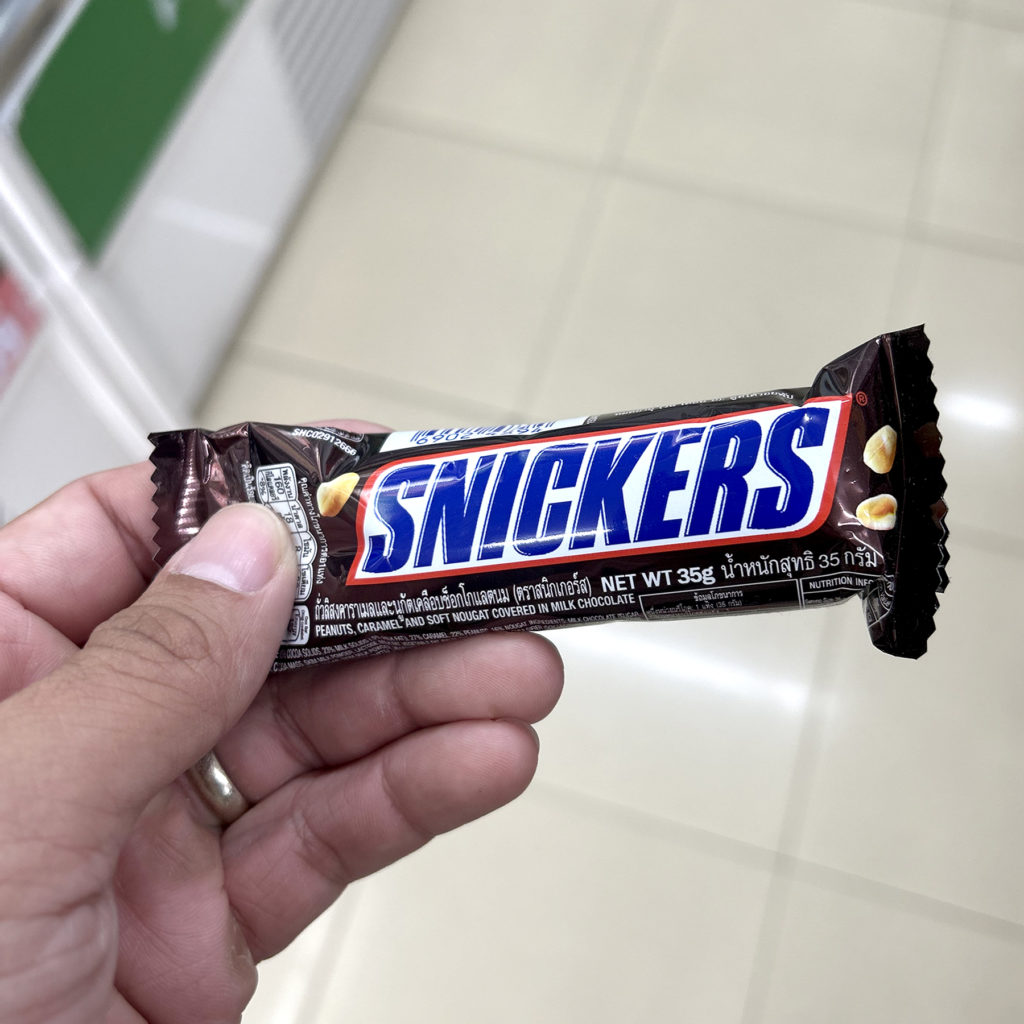
A satisfying mix of nougat, caramel, and peanuts, all generously coated in milk chocolate, Snickers bars are more than just a chocolate treat—they’re a filling snack. Snickers really fall under the best chocolate bar you can buy when you’re hungry, and you’re not yourself (cheers to those got this as Snickers’ tagline!).
You can easily get these at any convenience store or grocery store—perfect for those mid-afternoon hunger pangs!
Best Chocolate You Can Buy 2: Cadbury
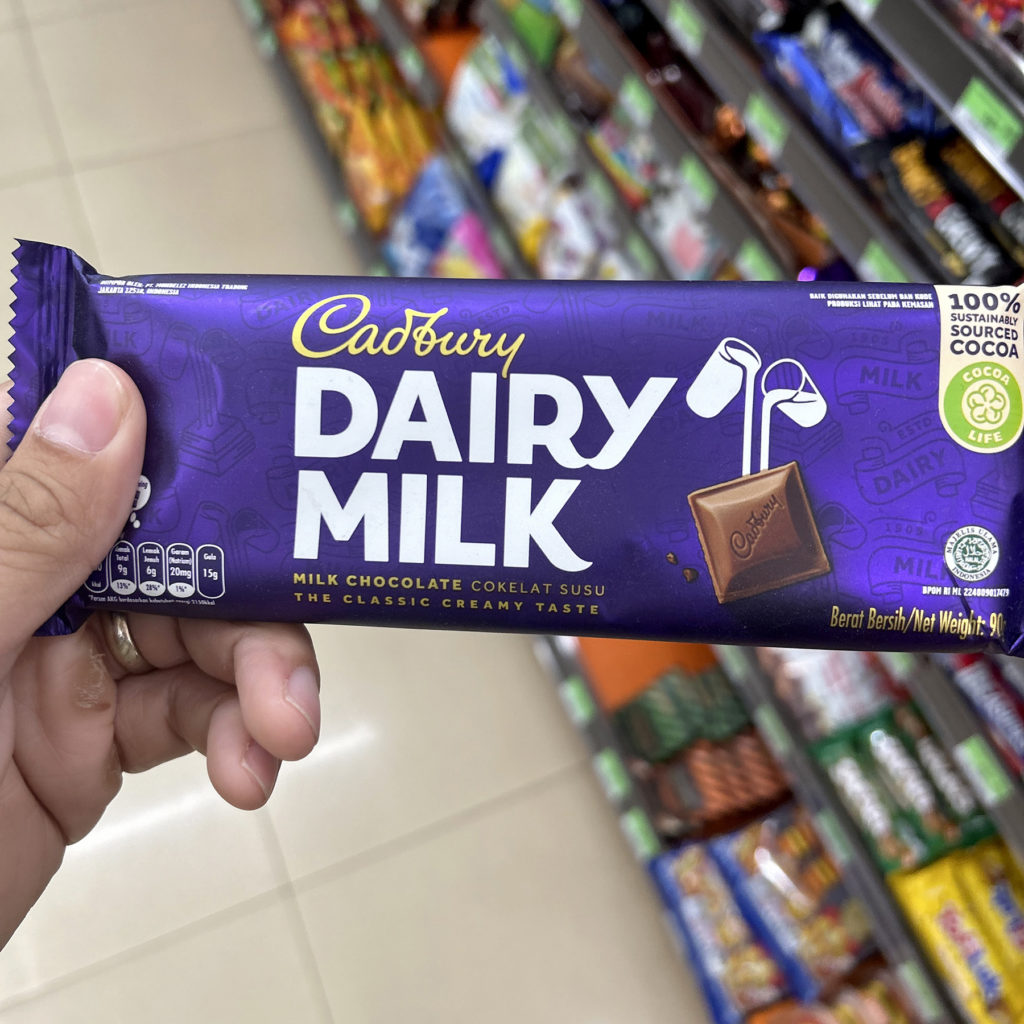
Cadbury is really popular for its smooth, creamy chocolate. They have a variety, but not necessarily adventurous flavors, like fruit and nut infusions. A lot of people love it – Cadbury apparently sells over 350 million Dairy Milk bars every year!
Also, Cadbury was the first to make heart-shaped chocolate boxes and probably making chocolate synonymous with special occasions. Pretty cool, isn’t it? Of course, thankfully, you don’t need any special occasions to indulge in a Cadbury—they’re pretty accessible in groceries and various convenience stores.
Best Chocolate You Can Buy 3: Reese’s Pieces
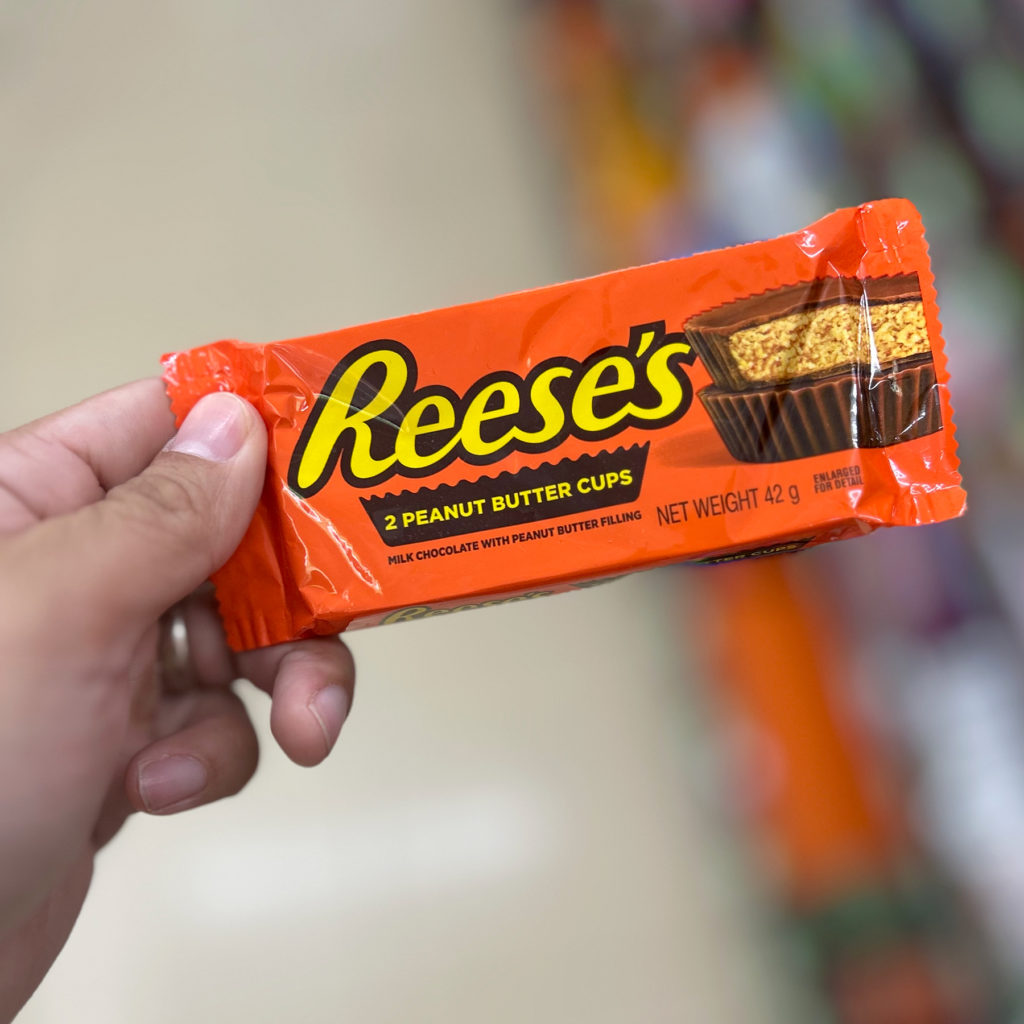
Reese’s Pieces are a big hit among peanut butter lovers. People praise their chocolate coating, the peanut butter inside, and the fact that they don’t melt in your hands. If you’re into peanut butter, these tiny, colorful candies with creamy centers, crunchy shells, and delicious flavor and texture combinations are definitely worth a try.
Best Chocolate You Can Buy 4: Kinder Joy
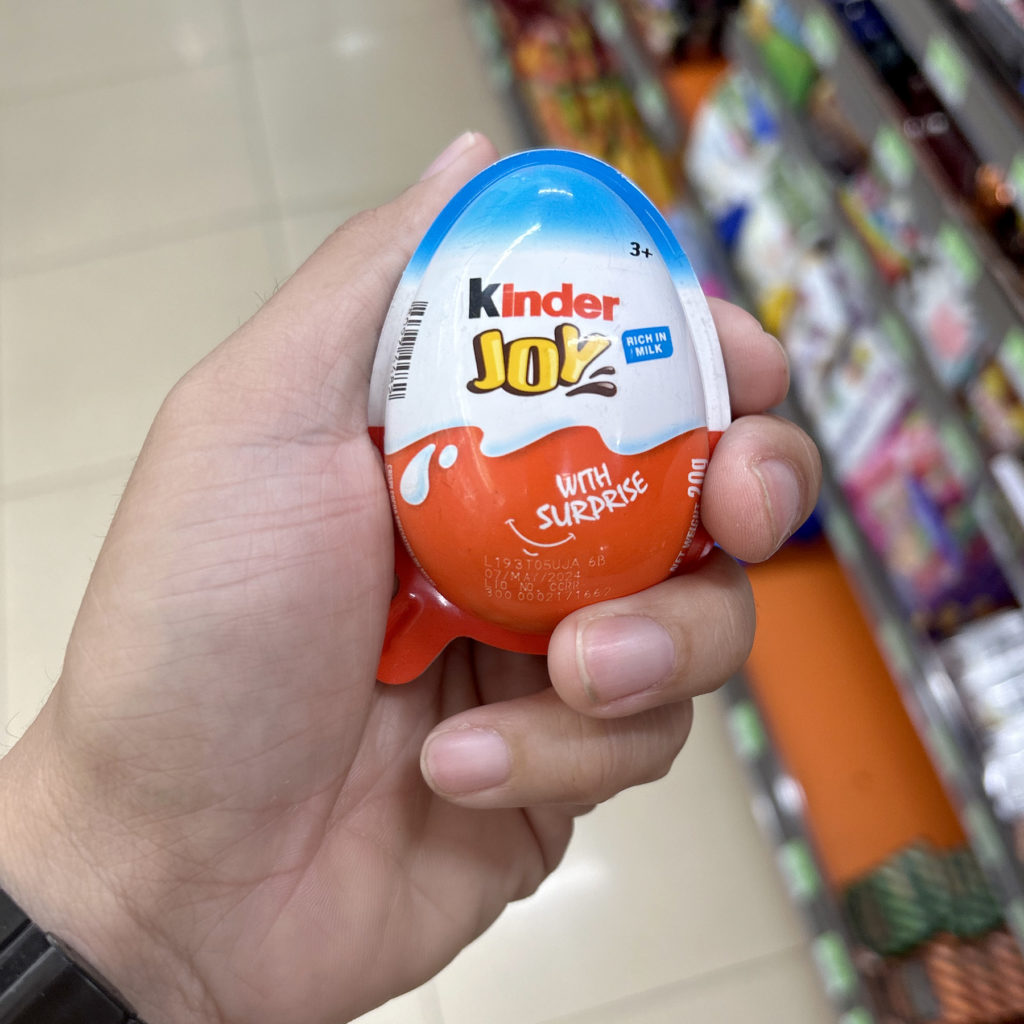
Kinder Joy chocolates are really fun because of the surprise toy inside. It’s exciting to open the egg and see what toy you get. And with so many different toys, you’ll always find something new and surprising.
But let’s not forget the chocolate, with people marveling over its smooth and creamy chocolate paired with crunchy nougat. Whether it’s the surprise element or the creamy texture, Kinder chocolates are a delightful treat for all ages.
Want you and your kid to enjoy this? Give your kid the toy inside, and eat the chocolate. Rinse and repeat for each kid.
Best Chocolate You Can Buy 5: Hershey’s

Hershey’s chocolate bars are a big favorite in America—and worldwide, too! They’re simple and well-loved for their rich, slightly sweet milk chocolate. People like them—maybe because these chocolate candy bars remind us of simpler times or classic moments.
Best Chocolate You Can Buy 6: KitKat
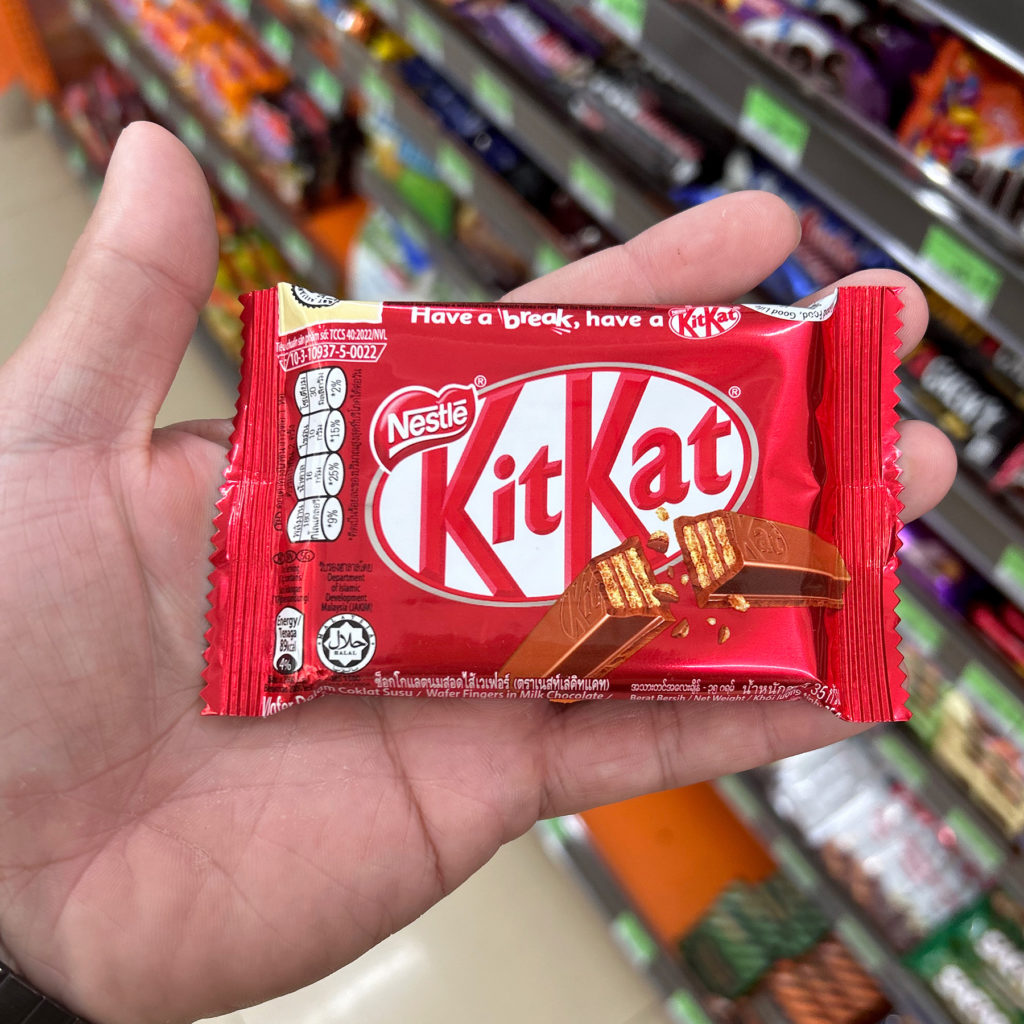
KitKats is famous for its jingle and its perfect mix of crispy wafer and smooth chocolate. They’re great for sharing or enjoying on a break. People really like KitKats for their taste and the bright red, easy-to-carry packaging.
KitKats are also fun to eat. You can choose to eat the chocolate bar by bar or break them into pieces. They come in different sizes, too—you can get a pack with 2 bars, 4 bars, or even 8!
Best Chocolate You Can Buy 7: Toblerone

Toblerone has been a favorite chocolate for a long time, especially in the Philippines since the 90s. We’re sure we’re not the only ones who loved it when relatives brought Toblerone as a chocolate gift from abroad. It’s still also well-known as a chocolate that Filipinos love.
It’s not just tasty with its mix of honey and almond nougat but also looks cool with its unique triangle shape. You don’t have to wait for people abroad anymore to experience this; it’s practically sold everywhere!
Best Chocolate You Can Buy 8: Ferrero Rocher
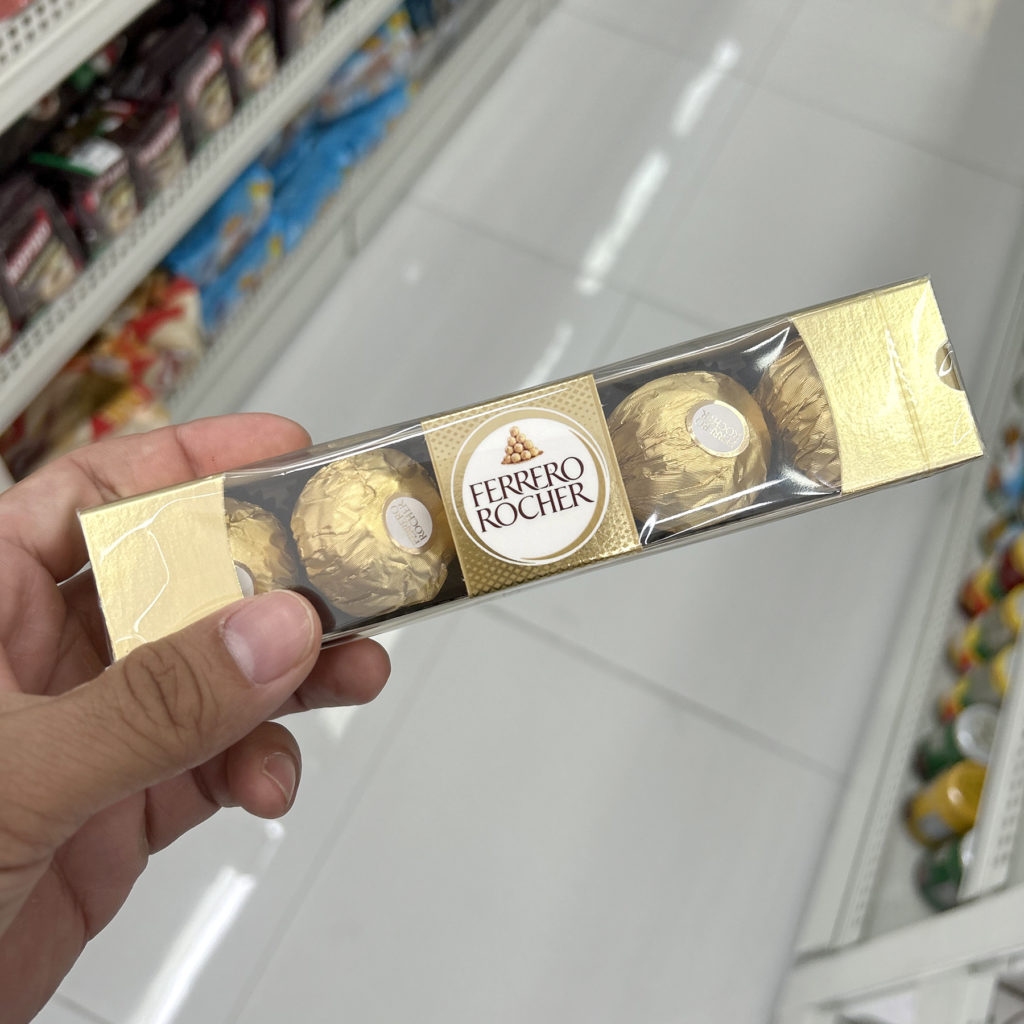
For a more luxurious treat, Ferrero Rocher’s layers of wafer, hazelnut, and chocolate are unmatched. Each individually wrapped piece is a little sphere of heaven, making them great for gifts too!
Before, you couldn’t buy this just anywhere, but thankfully, Ferreros are now being sold even in convenience stores.
Best Chocolate You Can Buy 9: M&Ms

Here’s another brand that gives a fun element to the eater. M&Ms’ colorful chocolate coating makes each piece a treat to the eyes and makes it more appealing to eat. And, of course, it helps that they don’t melt in your hand, but they definitely melt deliciously in your mouth!
Each bag comes with a different number of colorful chocolate shells. You never know what you’ll get, which adds to the thrill of opening up a bag of hard candy with a satisfying crunch.
Best Chocolate You Can Buy 10: Mars

Are you a caramel lover but aren’t a fan of nuts? Well, Snickers are out, but Mars bars? Definitely in!
Some may find the Mars bar a bit too cloyingly sweet because of its soft nougat and caramel covered in rich chocolate, but the majority of people love the flavor combination. Bite into one when you need a burst of energy or just some sweet comfort.
For Those Who Are Chocolate Lovers, But…
You might look for delicious chocolates if you’re feeling down, but what if you have to be mindful about sugar intake or you have to guard your weight? Well, here are some ways to stay true to your health goals:
- Opt for Dark Chocolate: Dark chocolate is a great choice for those managing sugar intake. It typically contains less sugar than milk chocolate and is rich in cocoa, which is known for its health benefits.
- Portion Control: Enjoying chocolate in moderation is key. Opt for smaller portions or individually wrapped pieces so you can savor the taste without overindulging.
- Sugar-Free Options: Many brands offer sugar-free or low-sugar chocolate options. These products use sugar alternatives to provide sweetness, allowing you to enjoy chocolate without impacting your sugar levels.
- Focus on Quality, Not Quantity: Choose high-quality chocolate with pure ingredients. The richer the flavor, the less you may need to feel content.
- Balanced Diet: Incorporate your chocolate treat into a balanced diet. Pairing a piece of chocolate with healthy foods like fruits or nuts can balance your overall intake while still allowing you to enjoy your favorite treat.
Being health-conscious doesn’t mean giving up on chocolate. It’s all about making smarter choices.
Of course, it would help if you just had chocolates that were totally guilt-free, right? Well, it’s definitely possible!
Introducing the Keto Candy Bars Class by The Bailiwick Academy!
Check out our latest class with Ms. Chiqui Ortiz Dingcong: Keto Candy Bars!
You can create four kinds, each with a unique flavor:
Keto Chocolate Hazelnut Balls, a delicious combination of chocolate and crisp hazelnuts in perfectly portioned keto-friendly bites; Keto Peanut Butter Cups, where creamy peanut butter meets luscious sugar-free chocolate; Keto Chocolate Almond Bars, made with a blend of chocolate, roasted almonds, and coconut; and Keto Choco Caramel Candy Bars, boasting rich chocolate, velvety caramel, and a delectable crunchy shortbread cookie!
Not only will these be great to reach for when you’re looking to eat some chocolate, you can also add them to your food business menu—especially in time for the holidays!
What are you waiting for? Make some fine chocolate today that’s totally guilt-free! Sign up at The Bailiwick Academy today!
—
Keep coming back to The Bailiwick Academy blog for more baking and cooking tips, kitchen tricks, and much more!
Why make and give edible Christmas gifts?
Christmas food gifts are a thoughtful, inclusive, and delicious way to create lasting holiday memories and spread cheer. By investing time and care into baking or creating a culinary treat, you showcase your skills and creativity, making each gift a unique expression of affection. These gifts are delightful to receive, won’t contribute to clutter, and can be customized to suit individual tastes and dietary needs.
Convinced? Great! Now, if you’re wondering, “What can I make as Christmas gifts?”, well, we’ve got you!
On to the seven ideas!
Edible Christmas Gift Ideas To Make 1: Homemade Cookies

Homemade cookies are a timeless and delightful choice as one of your choices for Christmas gift ideas. You can make different flavors and styles that will suit everyone’s taste. It doesn’t have to be holiday-themed either, like gingerbread men or cookies shaped into candy canes—classic cookie shapes and flavors like chocolate chip cookies will do.
But if you want to keep with the season, pack them in decorative tins or cellophane bags tied with festive ribbons. And there, you have an easy, DIY gift of Christmas cookies!
Thinking of what cookies to make? Choose from these classes here at The Bailiwick Academy: Gourmet Cookies by Chef Bam Piencenaves, Best Ever Cookies by Chef Joey Prats, and Unique Cookie Concepts by Chef Miko Aspiras.
Edible Christmas Gift Ideas To Make 2: Polvoron In A Jar
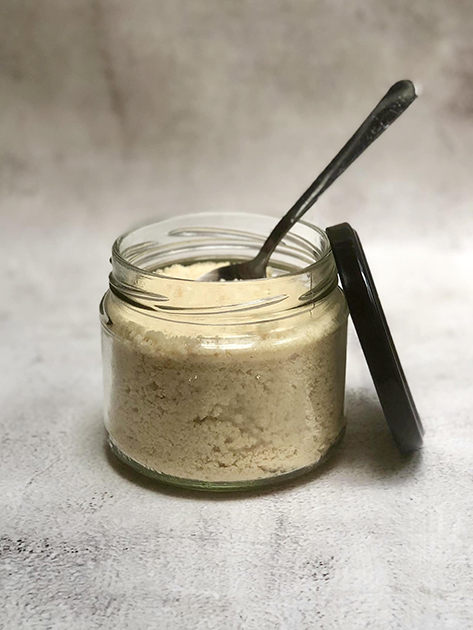
Polvoron traditionally is eaten molded into shapes, but why not give your loved ones something different? For this holiday season, surprise your loved ones with a creative twist on this classic delicacy by presenting the polvoron powder in mason jars. You can add a spoon so that they can eat out of the jar, but you can also attach instructions on how to mix and mold the polvoron, turning these edible gifts into a cute, delightful activity.
Looking for the best polvoron recipe possible? Check out Chef Miko Aspiras’ Madrid Fusiòn Polvoron class.
Edible Christmas Gift Ideas To Make 3: Cakes In Cans
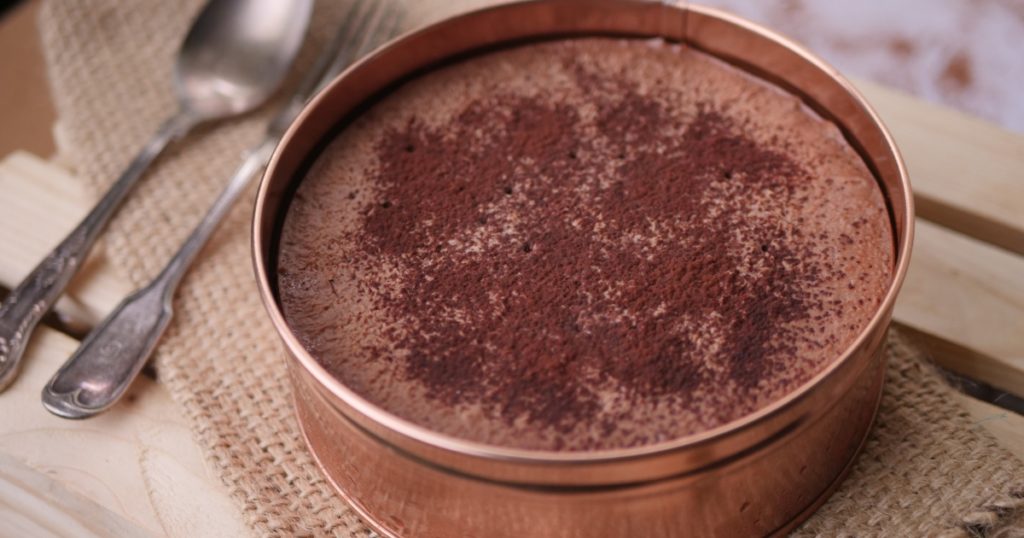
Cakes in cans are a fun and unique edible gift idea for Christmas. Simply bake your favorite cake dessert recipes in a clean, empty can, and you’ve got a portable and delightful item great for Christmas gifting. You have the freedom to choose any cake recipe you like, from chocolate fudge to white chocolate to fruitcake.
Once baked and cooled, you can decorate the can with ribbons or stickers and add a little note to make it personal. This DIY gift is not only tasty but also shows your creative side.
Want to give these as gifts during the festive season? Check out Chef Joey Prats’ The Cake Cannery class or Ms. Chiqui Ortiz-Dingcong’s Keto Cheesecakes class for sugar-free, guilt-free options.
Edible Christmas Gift Ideas To Make 4: Pie
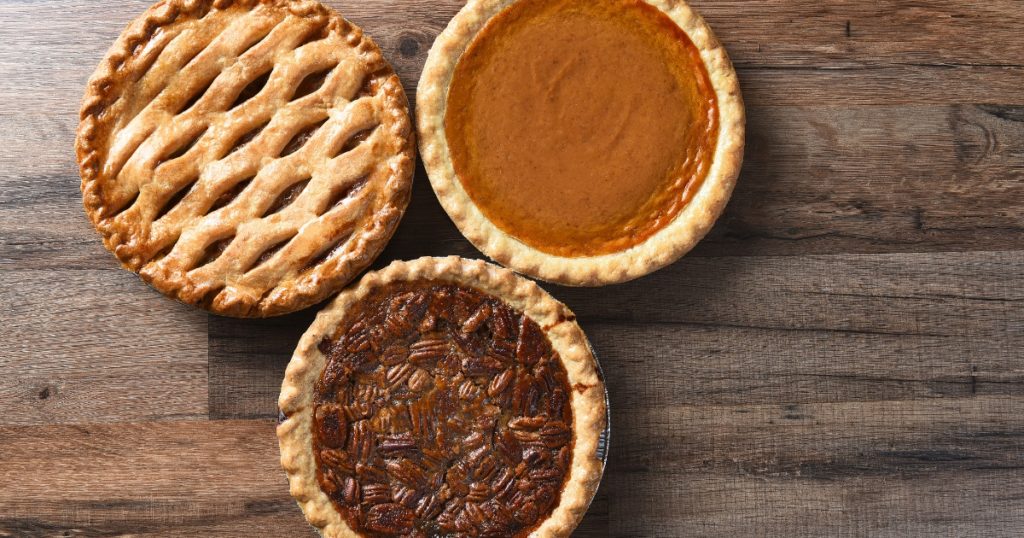
Homemade pie is a heartwarming gift that brings comfort and joy during the holiday season. Whether it’s a classic apple pie or every Pinoy’s favorite pasalubong, buko pie, it’s sure to be a hit. Bake it in a disposable pie tin, let it cool, and then wrap it up with some festive wrapping or place it in a pie box.
Add a little tag with a sweet message or the recipe, and your delicious, thoughtful food gifts are ready to go!
Looking for an easy recipe to make pies? Check out Chef Jimbo de Panadero’s Bakery-Style Buko Pie class or Chef Joey Prats’ Fabulous Pies class.
Edible Christmas Gift Ideas To Make 5: Savory Treats In Jars
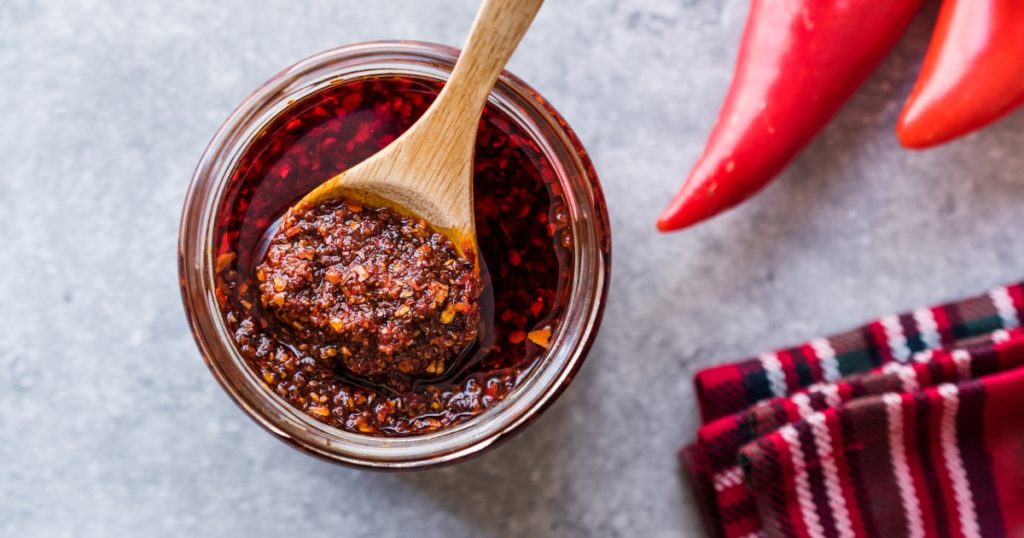
Not everyone has a sweet tooth, and that’s where savory treats in jars come in handy. You can layer ingredients for a soup mix, create a homemade spice blend, or even jar up some chili oil, marinated olives or feta. These edible Christmas gifts in a jar are not only tasty but also show that you’ve put thought into catering to different tastes.
It’s definitely a great way to introduce friends and family to new flavors and recipes—and are great for business way after the holiday season.
To get more specific, you can:
- Enroll in Gourmet in a Bottle by Chef Chona Garcia-Laureta for some long-lasting, gourmet fish treats;
- Get Chef Allan Mertola’s recipe for Chili Garlic Sauce in his Dimsum 101 class, which we’ve heard are best-sellers for plenty of Bailiwickers; or
- Take Chef RV Manabat’s All-Natural Meat Processing class and learn his recipe for preservative-free Garlic Atsara, which, as we all know, is enjoyed by many Pinoys!
Edible Christmas Gift Ideas To Make 6: Christmas Ham
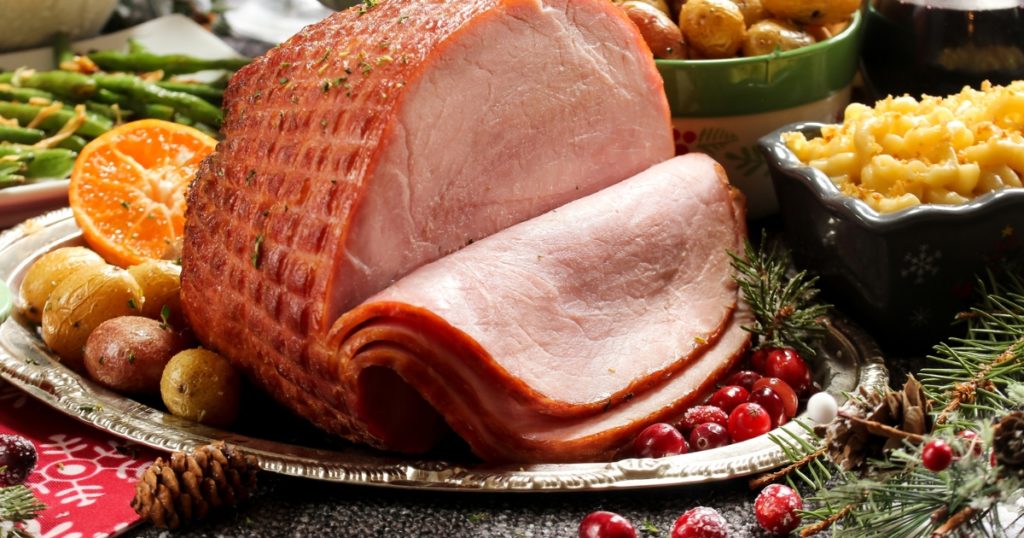
A Christmas ham is already a popular Christmas gift idea here in the Philippines, so why not make your own for a really perfect gift? You can be sure that receivers will appreciate this homemade edible gift, especially during family dinners for the holiday season.
And if you want to make some of the best hams ever, enroll in Sir Rodney Martinez’ Delicious Glazed Hams class. Make two kinds of hams and glazes that will take your loved ones’ ham experience to the next level!
Edible Christmas Gift Ideas To Make 7: Chocolate Truffles
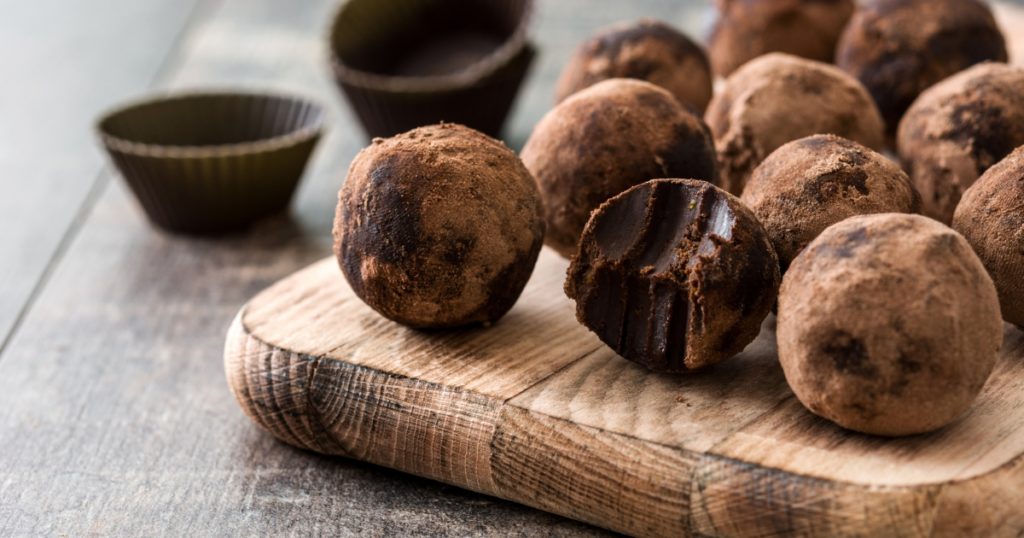
Chocolate truffles are luxurious and decadent homemade Christmas gifts, perfect for those who appreciate the finer things in life. You can make them at home using good quality chocolate, cream, and a bit of butter, then roll them in cocoa powder, chopped nuts, or coconut flakes. Place them in a small box or cellophane bag tied with a ribbon, and you have an elegant gift ready to go.
And believe us, when you give these as gifts for friends, they will love you for life! After all, chocolate truffles are not just a gift; they’re an experience, rich and full of flavor. When you taste your creation, this homemade gift might not make it to your loved ones—they’re that good!
Speaking Of Chocolate Truffles…
If you’re on the hunt for a treat that’s both easy to make and irresistibly delicious, you’ve hit the jackpot! Check out Chef Chona Garcia Laureta’s class: Chocolate Cookie Truffles!
Enroll in this class and get an easy recipe for no-bake Chocolate Cookie Truffles! Imagine biting into a glossy chocolate shell and finding a velvety, melt-in-your-mouth center – that’s exactly what these truffles offer. They’ll strike the perfect balance between simplicity and indulgence, and are suitable for any occasion, making them a versatile gift option, not just during the holidays.
Ready to dive in? Sign up at The Bailiwick Academy today to start making these homemade food gifts! They’re simple but decadently delicious treats that are sure to impress!
Final Thoughts
We hope you found one you want to try from this list of edible Christmas gift ideas to make! This holiday season, let your loved ones know just how much you care with thoughtful, homemade gifts. From sweet to savory, there’s a delightful option for everyone.
Get creative, personalize your gifts, and embrace the joy of giving. Happy holidays!
—
Keep coming back to The Bailiwick Academy blog for more baking and cooking tips, kitchen tricks, and much more!
]]>